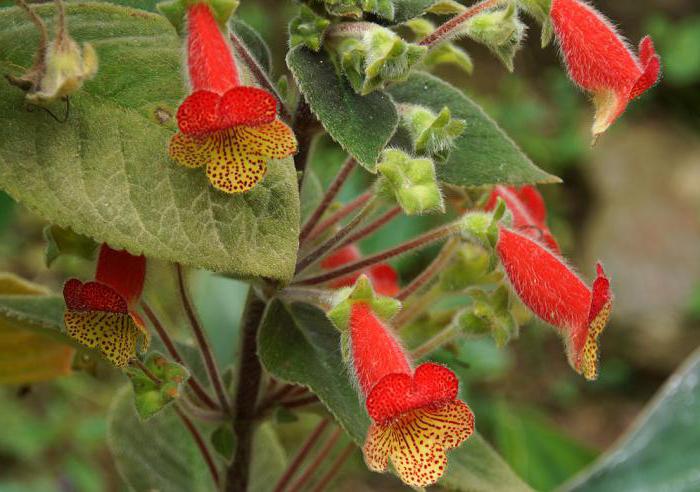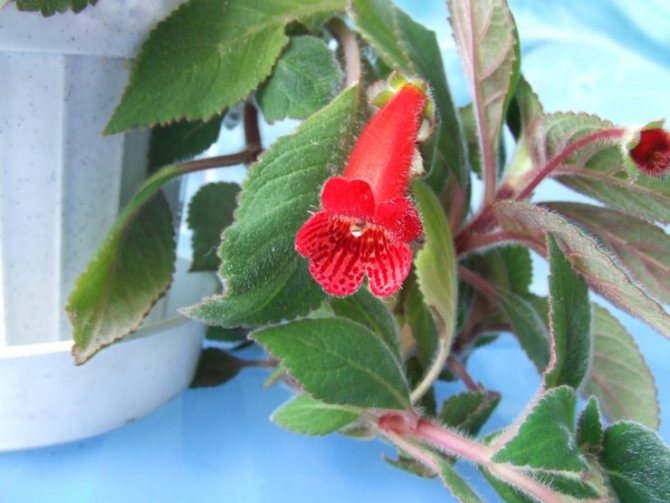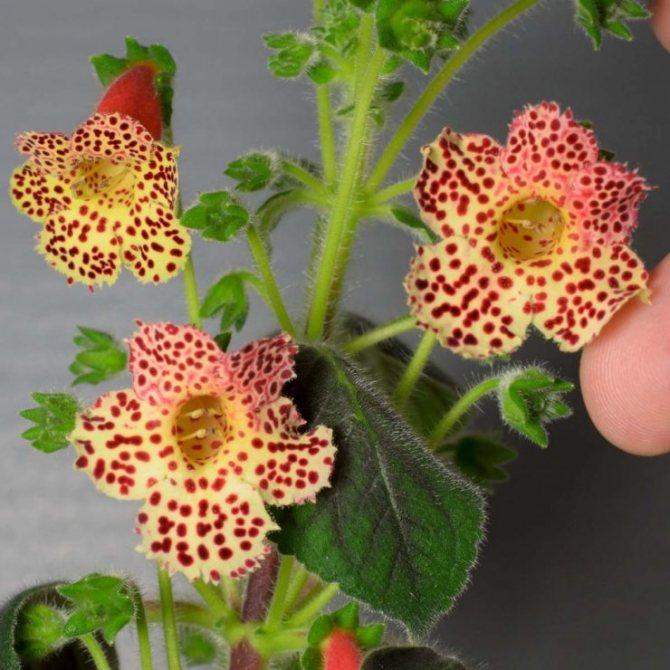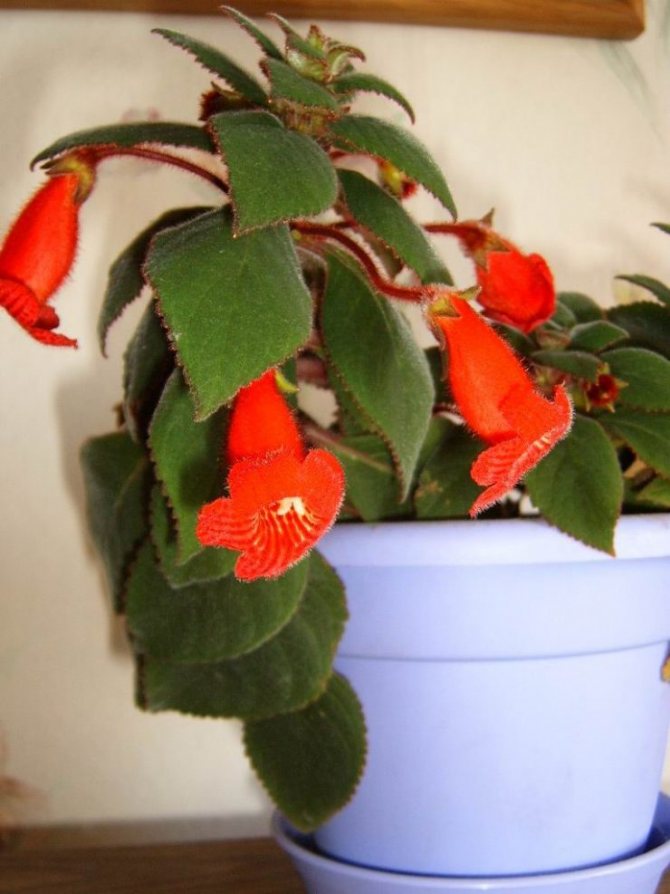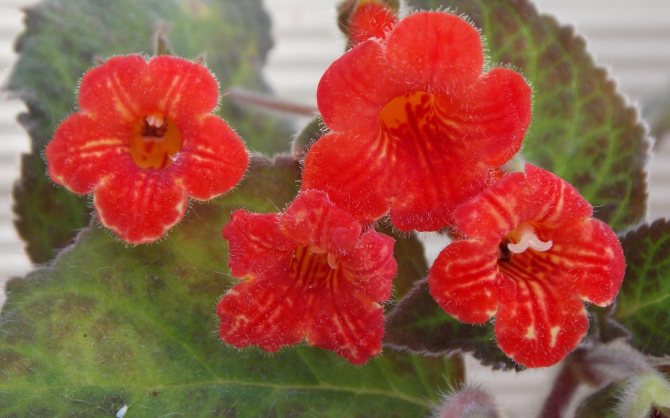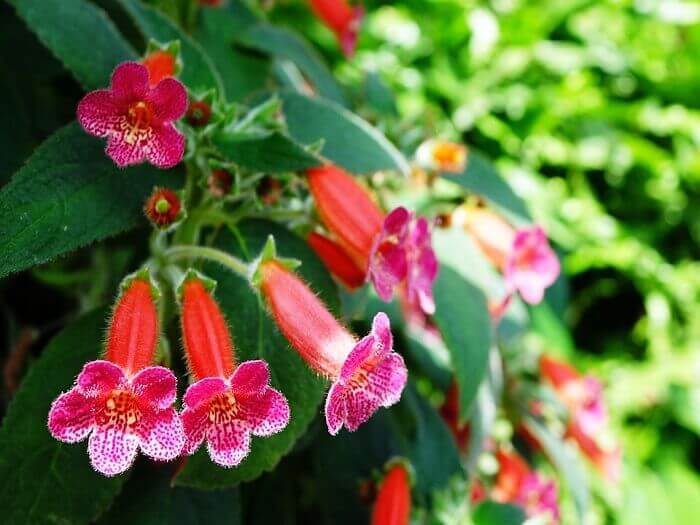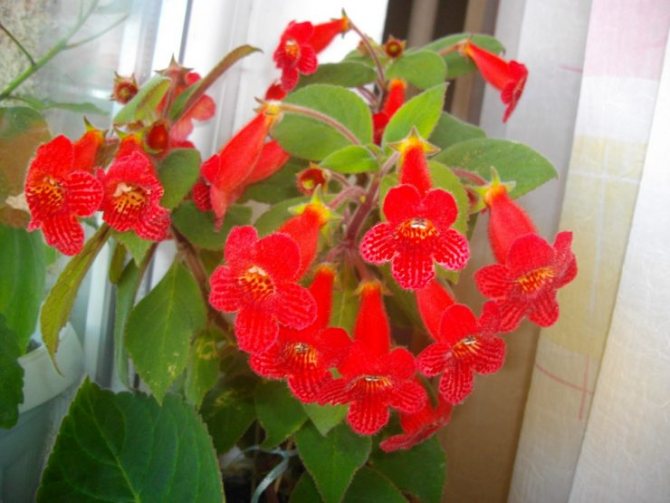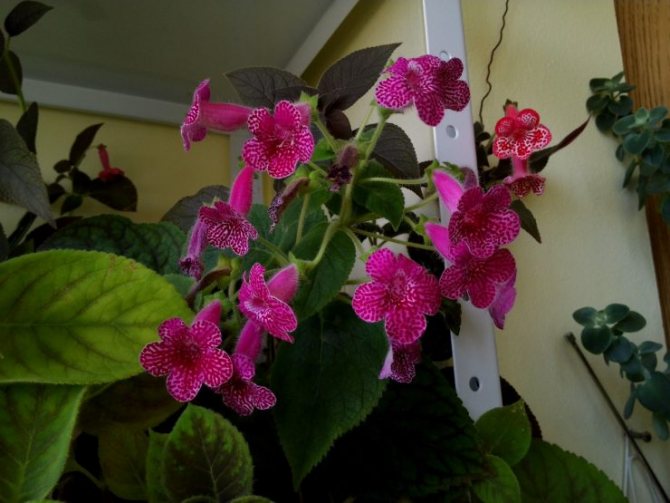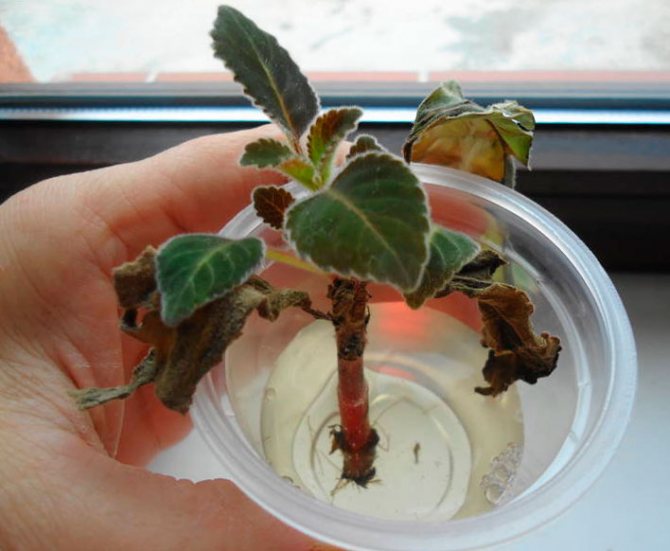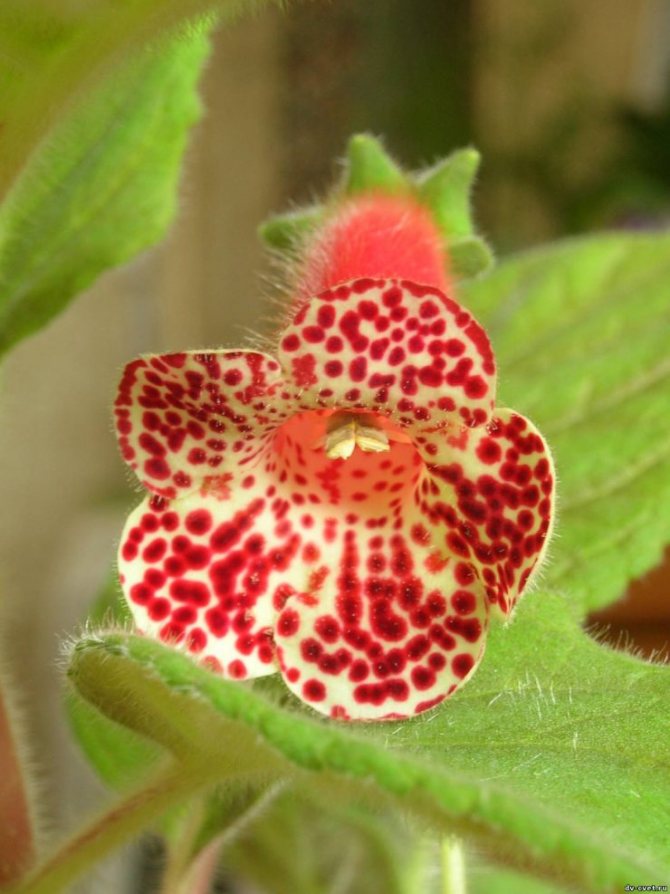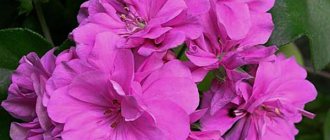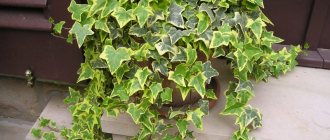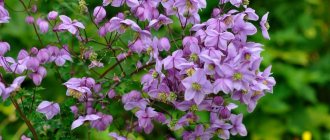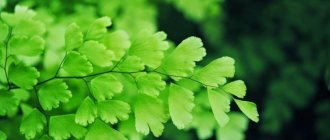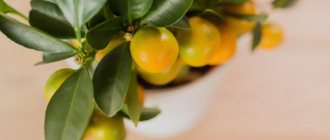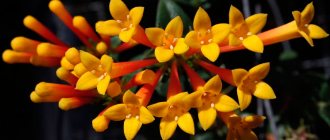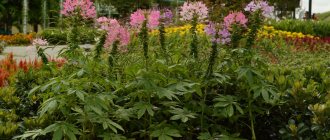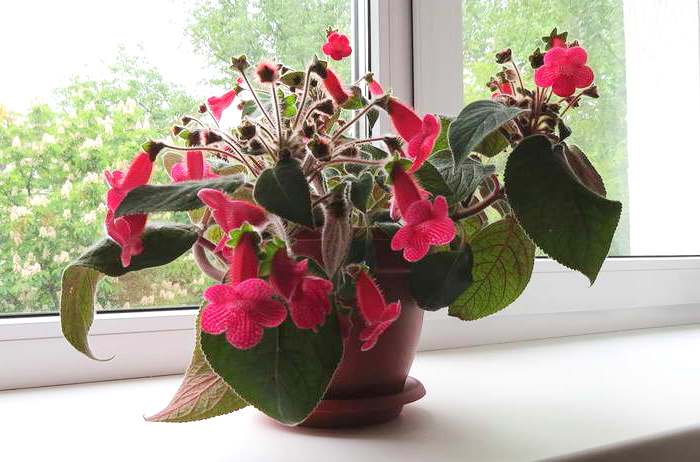
Coleria is an unpretentious flower, even a beginner from floriculture can cope with its cultivation. Its leaves are great in themselves, but if you want to enjoy continuous flowering almost all year round, you will have to learn a few simple rules for caring for Coleria at home. Let's talk about them in order.
Life cycle and dormant period of koleria.
Coleria is a plant with a pronounced dormant period, but there are species that do not shed the aerial part during the dormant period. Such koleriy need standard conditions of maintenance and watering all year round.
Fall. In November, Coleria is preparing to go into hibernation, flowering stops, the leaves begin to dry on the plant, and the leaves turn yellow. As soon as Gloxinia has begun the process of transition to the dormant period, it is necessary to gradually reduce watering.
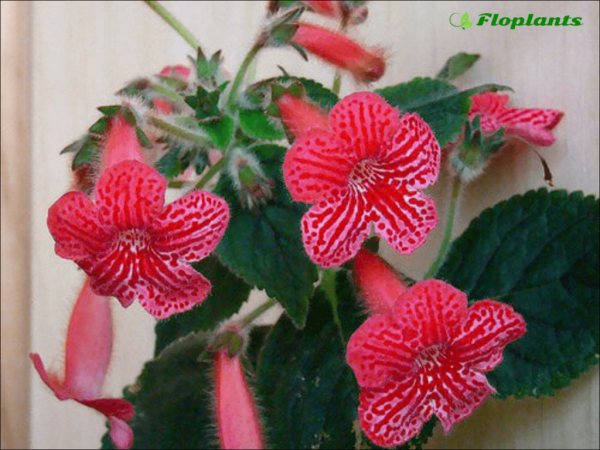

Winter. After all the foliage of the plant has died, it is necessary to remove all dried parts, and significantly reduce watering, but not stop completely, since even during the dormant period, the koleria has vital activity, albeit slowed down. The pot with the plant should be placed in a cool, bright place, for example, on a veranda or a glazed balcony. The ideal storage temperature is 15-17 ° C.
Spring. When daylight hours begin to increase, the temperature of the content of Coleria must be increased in order for the plant to begin to awaken and accelerate the processes of vital activity. When the first shoots appear, watering should be started to gradually increase watering. Corelia begins to bloom in early July.
Temperature
Coleria feels good at moderate temperatures. In spring and summer, a temperature in the range of 22 - 26 degrees will be suitable. Then the flower will actively develop and bloom profusely. At elevated temperatures, such a misfortune can happen: new buds will begin to awaken on the stems, while the root system will not be able to provide new shoots with everything necessary for growth and flowering. In such conditions, new shoots will be weak and begin to die off. We advise you not to exceed the temperature of the content above the recommended.
If your flower has a dormant period after flowering, move it to a cooler, darker room with a living temperature of 15 - 17 grams. If the flower does not have a pronounced dormant period, leave it in the same place.
About caring for Kolleria:
Temperature: Coleria is thermophilic, the optimum temperature for it is 20-25 ° C. Like all Gesneriaceae, this plant does not treat drafts well, especially winter cold drafts are destructive for it.
Lighting. This plant is photophilous, windows of the western or eastern direction will be optimal for it. South-facing windows may require shading from the midday sun. When choosing a place, take into account the factor that the plant is afraid of drafts, therefore, a window that is often opened for airing koleria is completely inappropriate.
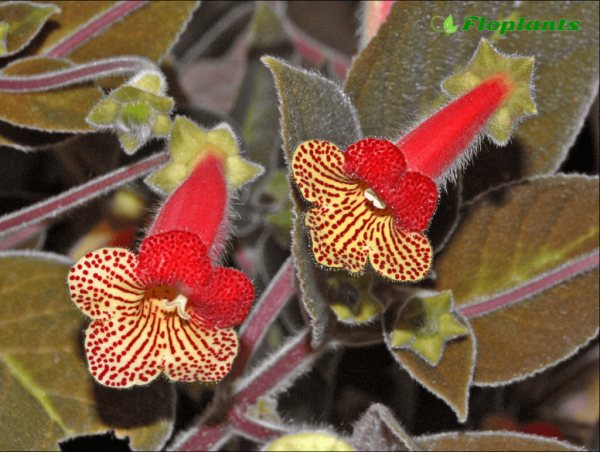

Watering. They prefer a moderate plant, watering without waterlogging and drying out the soil. The watering is regulated in accordance with the season, watering is more abundant in summer, watering is slightly reduced in autumn. If the aboveground part of the Corellia has not died out in the winter, the plant is watered in the same way as in the fall.Water for irrigation should be soft, settled or rain, room temperature or slightly warmer. Watering is necessary through the pallet or on the ground, avoiding moisture on the delicate leaves and buds.
Air humidity. Corelia prefers humid air, but is adaptable and can grow well in a dry apartment climate. To create moisture, you can use pallets with wet expanded clay or sphagnum moss, you can also spray the air around the plant, avoiding moisture on the leaves and buds. Use only soft water for spraying.
Fertilizers: Fertilization starts around April and ends with the dormant period around August. In winter, the application of all fertilizers must be stopped, even if the corelia has not dropped the aboveground part. When choosing a fertilizer, it is necessary to give preference to a fertilizer for ornamental flowering plants with a high content of phosphorus and potassium. You should not take fertilizers with a predominance of nitrogen, since thanks to nitrogen, the plant will grow a lot of greenery, and this will affect the splendor of the flowering. Fertilizer is diluted in half dose and watered once a week.
The soil. For Corellia, Saintpaulia soil is excellent, which can be additionally added with charcoal. The pot for the plant should be wide and shallow, and a thick layer of drainage should be provided at the bottom.


Transfer. Annually, as the plant tends to grow quickly enough. Corelia is transplanted in March - April, as soon as the plant begins to emerge from a dormant period, using the transshipment method. It is important to have time to transplant before the buds are laid, since during this period stress is undesirable for Corelia.
Pests. Corelia is a hardy plant that is rarely damaged by pests, but can sometimes fall prey to spider mites, aphids and mealybugs.
Pests
Subject to the rules for keeping a flower, pests attack it quite rarely. In addition, the whole plant is covered with villi, which prevent the penetration of parasites to the juicy pulp of the plant. However, sometimes this happens and spider mites, aphids or mealybugs still spoil Koleria's life. These parasites suck out all the juice from the succulent leaves of the plant, which leads to wilting of the leaves, deformation of the buds and a complete stop in the development of the flower.
At the first sign of insects, treat the flower with soapy water in the bathroom or at least warm water from the shower. You will wash off most of the pests, but in order to get rid of all adults and their larvae once and for all, you will have to treat the plant with some kind of insecticide, such as actellic, aktara, phytoverm, malofos and many others according to the instructions for the preparation. One treatment may not be enough, repeat the procedure after a week (read the instructions carefully).
Formation and pruning of color.
Corelia needs care, which consists in maintaining the shape and decorativeness of the plant. If the root is not pinched, the shoots will stretch ugly, lose foliage and flowering will eventually become scarce. Corelia is grown ampelno as all the shoots of the plant tend to lie down. In order for the bush to be neat, all the shoots must be pinched, when they reach 20-30 cm by about a third, this stimulates the formation of axillary buds and subsequent branching.


Description of kaleria flower
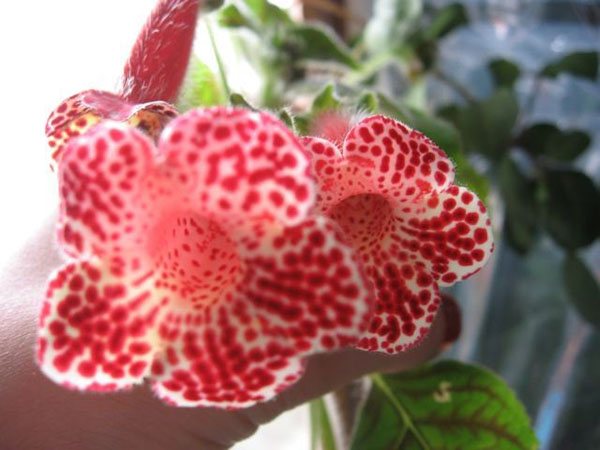

About 65 species of this plant are known, which can be seen in nature in the tropical regions of Central America. Its distinctive feature is the opposite, pubescent leaves with a variety of colors, from bright green to bronze. But the main reason why the kaleria flower, such as the one in the photo, has become popular among indoor plants, is the original flowers. The plant forms them from spring to autumn with minor interruptions.
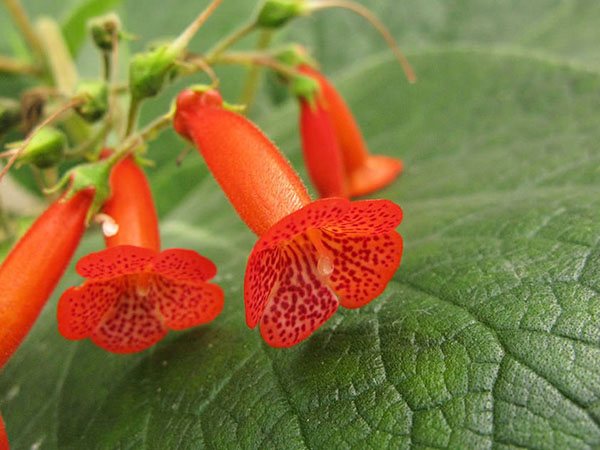

The flowers resemble modified bells that have an elongated corolla. Their color can be different: from pink to dark brown, interspersed with a different shade. Most often, hybrids are grown at home, which have a long flowering period.
Reproduction of Koleria:
Corelia reproduces by dividing the rhizome, cuttings and seeds. Reproduction of the plant is carried out in the spring, it is during this period that the chances of success are highest.
By dividing the rhizomes, old plant specimens are most often propagated, which have enough lateral shoots. The division is carried out in the spring, during transplantation. In order to get new specimens of Corellia, it is necessary to divide the roots of the plant so that each part has several formed shoots with a sufficient number of roots.
Propagation by cuttings is one of the easiest ways to get a new plant, even if the existing one is still young. Most often, with such reproduction, cuttings obtained by pinching the plant are used. Rooting takes place successfully both in an earthen mixture and in water with the addition of root and activated carbon. In the ground, the first roots appear within a week.
Some growers practice reproduction of Corellia from a leaf. The method is completely similar to cuttings propagation, but it takes more time. The leaf is placed in water to obtain roots, after which it is planted in the ground.
Seed propagation is not only the most laborious, but also less successful; in addition, plants obtained from seeds do not always retain their varietal qualities. In order to try to get Corelia from seeds, planting must be carried out in February-March. When planting, the seeds are not buried and watered from a spray bottle, after which they are covered with cling film, glass or a bag, creating a greenhouse effect. The first shoots can be seen within a few weeks. A pick is carried out when 5-6 leaves appear.


The popularity of growing room color is due to its high decorative effect and a long flowering period. Despite the exactingness to the temperature and humidity characteristics of the air and the quality of the soil, caring for color at home is very simple. From this publication you will learn about the most common varieties, maintenance features and breeding methods of this unpretentious plant.
If you want to buy a color scheme ...
Before you buy a painting, you need to examine it well. The leaves should have a uniform color, they should not be stained or rotted. It is advisable to purchase an already flowering plant to make sure that the variety was purchased that was planned.
Since the flower is very often affected by pests that can be overlooked when buying, it must be rinsed under a warm shower and placed separately from other plants for several weeks. If insects are found during this period, you need to immediately treat the color with an insecticide solution.


After treatment, the plant must be placed in a permanent growth site. It does not like permutations and turns, often from them it gets sick and even dies.
In astrology, koleriya is referred to as the colors of Aries - a fiery, hot, strong, decisive, bright and proud sign. Therefore, spectacular flowers of red, pink, burgundy and orange color are suitable for him.
Coleria of this color, living in the house, helps its residents become self-confident, increase your self-esteem, achieve success in your personal life and achieve your goals. She creates a favorable hospitable atmosphere, attracts new and interesting acquaintances, cleans the room of negative energy. She also empowers people with caution, compassion, and discretion.
Description of the plant
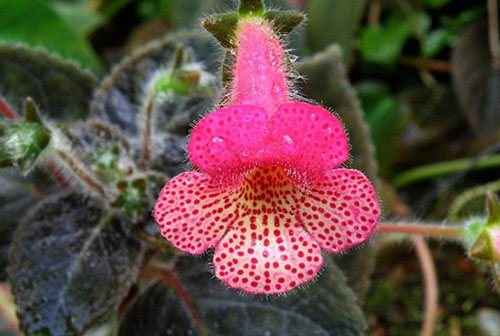

The koleriya flower is one of the representatives of the Gesneriaceae family.Natural habitats are tropical forests of Central America, Mexico, Colombia. Domestic flower growers, this representative of the flora is better known as the "Colombian bell". Among florists and florists, another name for kaleria is used - "Colombian beauty".
In nature, coleria is a perennial climbing plant with elongated, rather large and velvety leaves, which, depending on the species, can have a wide variety of colors with shades of green, bronze and silver.
Coleria flowers are bell-shaped with five petals, decorated with a contrasting pattern. As a rule, varieties of kaleria are grown under artificial conditions with red flowers, less often with bard and orange flowers. Depending on the species, the number of flowers on a peduncle varies from 1 to 3.
The flowering plant usually begins in late May (early June) and lasts until mid-October. The dormant period is from late October to mid-March. A characteristic feature of the plant during the transition to the dormant phase is the cessation of flowering, active foliage discharge, wilting of the apical shoots. However, in favorable climatic conditions and with proper care, the indoor flower kaleria can bloom almost all year round.
Botanical description
The plant is ampelous with ovoid-pointed leaves crenate at the edges. They are soft in texture, covered with a small pile of white or reddish color. In length they reach 12-15 cm, in width - up to 8 cm.The color is varied and depends on the variety: dark green with red veins, olive green with a lighter vein, silver or bronze, violet, purple and even gray-gray.
This plant is characterized by abundant flowering. On one peduncle there are several bell-shaped flowers up to 4 cm in diameter. With proper care, up to 15-20 flowers can form at one time. Some varieties of coleria need a dormant period that lasts about 60-90 days. Without it, budding may not occur. Axillary buds, formed under the leaves on small flowering legs. The most common varieties have orange and red petals. In the process of breeding, varieties were bred with lilac, pink, speckled, dark red, orange-red and reddish-brown bells.
Rhizome - thickened scaly.
Types of koleria suitable for growing at home
Of the 40 known varieties of koleria, only 11 have adapted well to growing in artificial conditions. Among the varieties most popular among domestic florists, the following varieties can be noted:
In addition to the aforementioned varieties, hybrids are very popular among flower growers. The following hybrids can be found in specialized stores: Peridot's Rolo; Flashdance; Queen victoria; Bibbi. A very decorative hybrid "Varshevich" is distinguished by lilac flowers, covered with thick silvery pile.


The folded back part of the petals has a white-yellow color with dark blotches.
Selected varieties of the Colombian beauty
As for hybrid plant varieties, their diversity is mainly due to the variety of flower shades, as well as the duration of flowering. It is worth noting that with proper care, koleria can bloom almost all year round..
Queen victoria
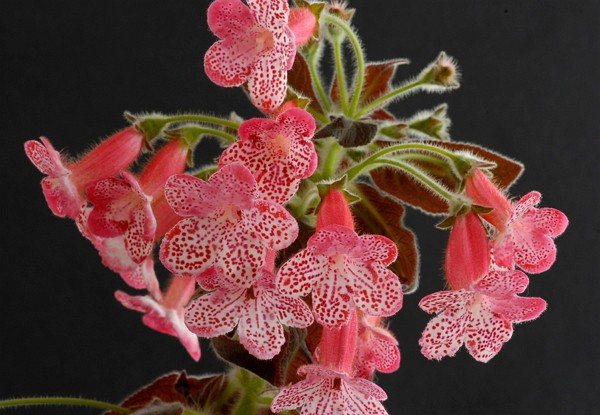

The species has bright red flowers in the form of a tube. The petals are pink with a pink border and interspersed with a beetroot shade.
Flashdance
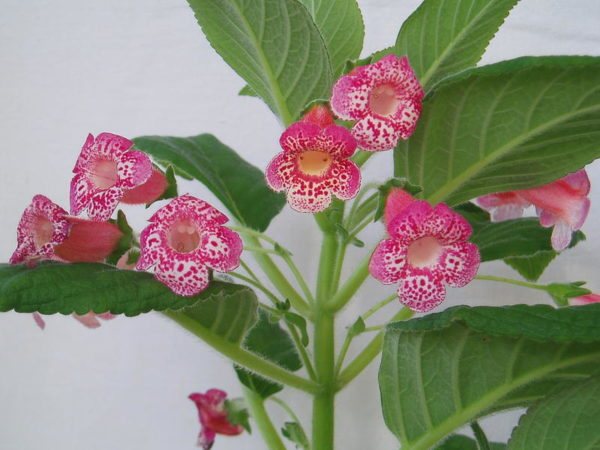

The tube of the inflorescence is rich yellow, and the outer petals are bright coral.
Bibbi


Scarlet flowers with delicate white petals. In addition, the inflorescences are decorated with blotches of cherry blossom. The leaves of this variety are quite fluffy and have a calm green tint..
Kolleria Varshevich
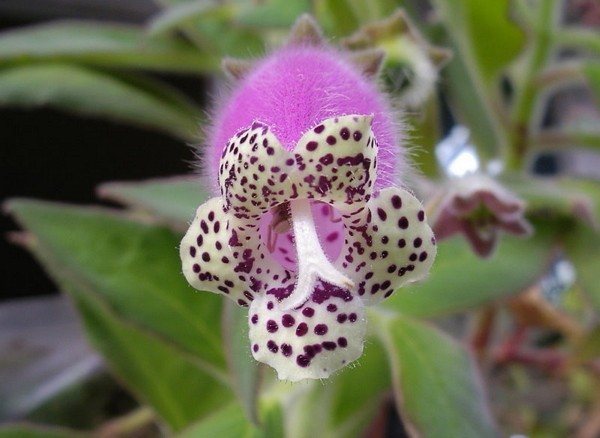

This one is distinguished from other species by large lilac buds with yellow petals.Blotches on the petals of a brown tint.
Jester


A plant with large crimson flowers with a light rim at the entrance to the pharynx. The petals are strewn with red dots that merge into stripes.
Red ryder
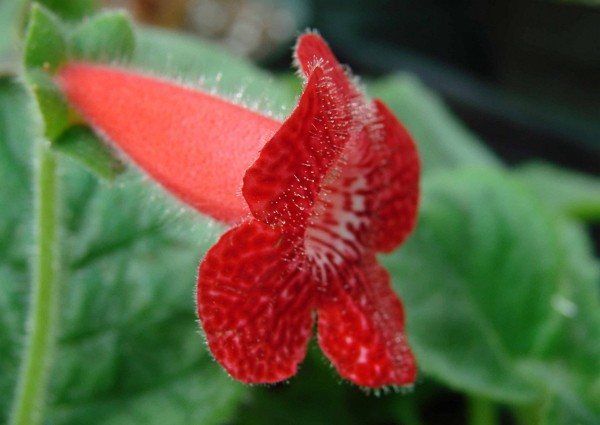

Large fluffy flowers with a red tube and fiery petals... At the same time, the inner surface of the throat is decorated with cherry dots. The leaves are large, velvety and slightly pointed.
Features of caring for color at home
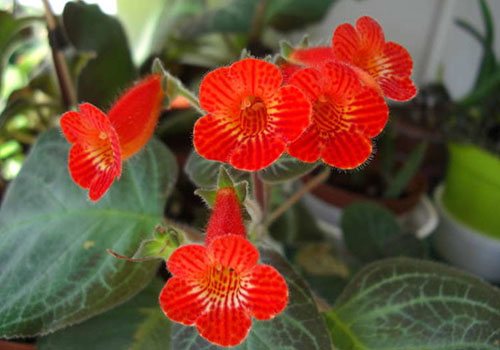

As already about - this is a very unpretentious plant, which usually does not require the creation of special conditions of detention. Nevertheless, like any "indigenous" inhabitant of the tropics, the plant requires a sufficient amount of light and moisture. The only condition is the organization of the diffused light. The sun's rays are detrimental to the vegetative part of the plant. Next, let's look at how to care for a kaleria flower at home.
Temperature and humidity
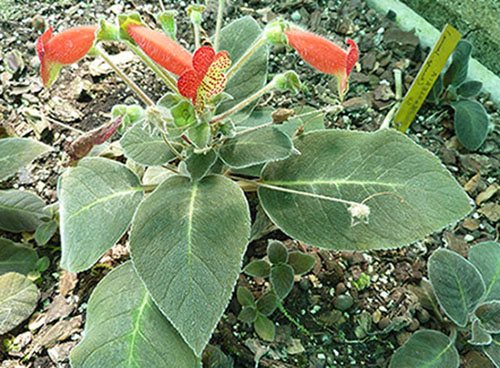

For active growth, the plant needs an elevated ambient temperature. In the summer, the optimal indicator is from +24 to + 30 ° С; in the cold season, the optimal temperature range is from + 15 to + 17 ° С. The air humidity in the room with the "Colombian bell" should be within 55%.


Watering the plant needs moderate. Optimally, this is root watering with settled water every 7 days.
Do not overmoisten the soil and spray the green mass of the plant. Excessive moisture in the soil can provoke lesions by fungal infections, and water droplets on the leaves can cause decay.
Plant care in winter
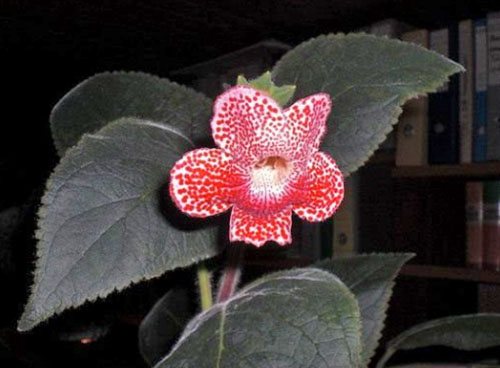

When the plant enters the resting phase, the bush should be cut to ground level, and then the container with the kaleria should be moved to a dark and cool place. Moistening the soil during this period should be done no more than 1 time in 30 days.
Ground requirements
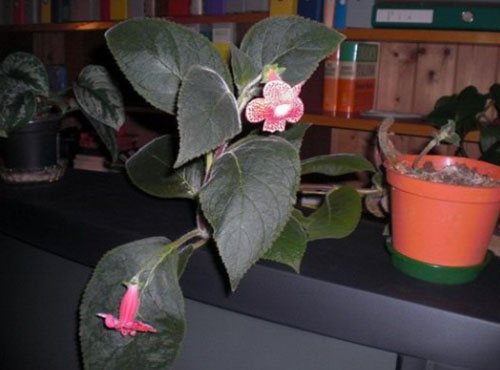

Kaleria loves light, nutritious, slightly acidic soil with good water permeability characteristics. The best option is a specialized soil mixture for Gesneriaceae. In the absence of such on sale, the soil for the "Colombian beauty" can be made independently. To do this, you need to mix in equal proportions: peat, garden soil, river sand.
All genserias respond well to mineral fertilizers and organic matter. Fertilizers should be applied every 14 days, starting in spring and ending with the first manifestations of the transition to the resting phase. During the period of active flowering, the plant needs regular feeding. Lush bloom will ensure that potash and phosphate fertilizers are applied to the soil every two weeks.
Crown formation
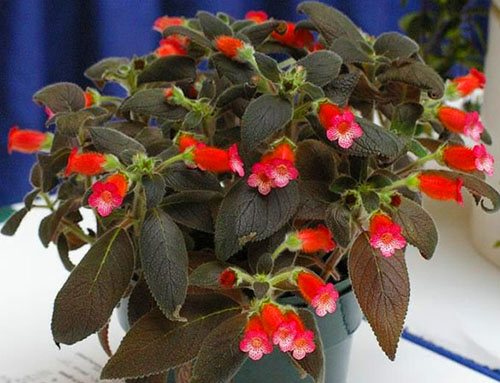

Trimming the top shoots of the bush allows you to get a lush flower. If you do not carry out the crown formation procedure, then the plant will be ampelous. This form is also highly valued among domestic florists.
It should be understood that the formation of the crown is allowed only before the onset of the period of active growth and flowering of the plant.
The most popular varieties of Corellia in the world
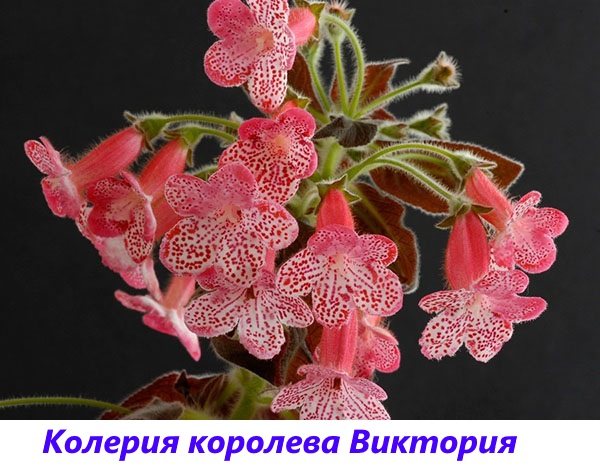

One of the most sought-after and unique varieties is Queen Victoria. This flower is distinguished by its extraordinary tenderness and beautiful pink shades. The neck is white. Leaves are plain, green. Young plates are straight, and adults are slightly inclined downward.


Equally famous is the Red Ryder Corelia. The bells of this variety are dark red. The neck is also whitish with small dots.
Breeding varieties:
Transplant and reproduction of coleria at home
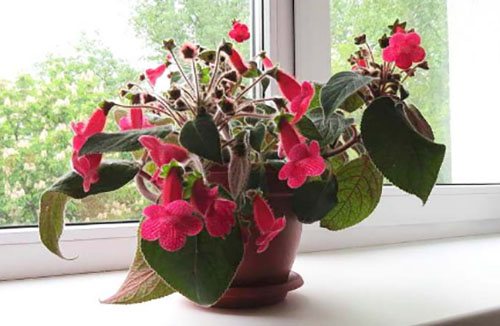

The "Colombian bell" is transplanted only in the spring before the onset of the active growth phase of the plant. For this, a shallow wide container is chosen, which will ensure maximum saturation of the soil with oxygen.
Coleria propagates by cuttings, seeds and parts of the rhizome, which in this plant are called rhizomes. The most popular breeding methods are apical cuttings.Such shoots take root equally well both in water and directly in the ground. Already on the 10th day, roots and new shoots, necessary for the normal rooting of the plant, will appear in the place where the shoot is cut.


When rooting the cuttings in the ground, cover the shoot with a plastic container to create a greenhouse effect.
Coleria rhizomes are growths on the root system, which serve to create the necessary supply of nutrients and moisture for the plant. It is very simple to propagate a flower with rhizomes: it is enough to put them in a pot on a layer of substrate and sprinkle with a soil mixture, with a layer of 3-4 cm.
Rhizomes can appear not only on the roots, but also on the shoots, as well as on the leaves of kaleria.
Of these, young shoots appear even in the air, which can be easily planted in the ground as described above.
Unpretentious collier at home - video
Coleria is a beautiful perennial herb that is easy to cultivate, but not widely popular with breeders. It is an ampelous plant with velvety green oblong leaves with a jagged edge and asymmetric bell-shaped flowers. Among florists, specimens with red flowers are in demand. Plants with pink, maroon and orange flowers are much less common.
Transplant and pot selection
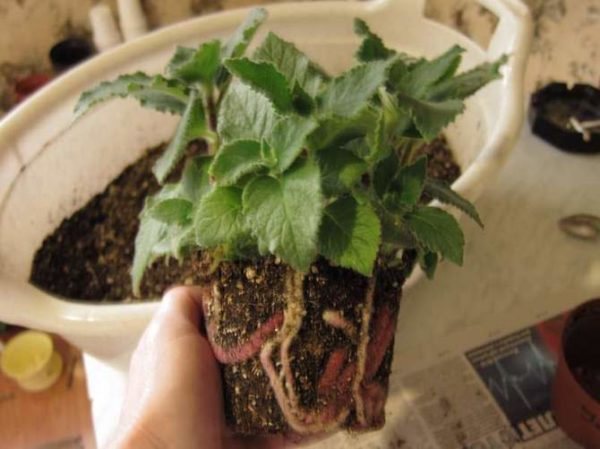

The flower grows quickly, its root system is developing well, so it needs an annual transplant into a more spacious pot. The flower is transplanted in early spring, when it is still in the dormant stage. It is impossible to transplant Koleria during its active growth, at the stage of laying buds and, especially, flowering. The flower will throw off the entire ovary, and you will be left without a gorgeous flowering for a long time. For transplanting, use the transshipment method, do not shake the soil from the roots of the plant.
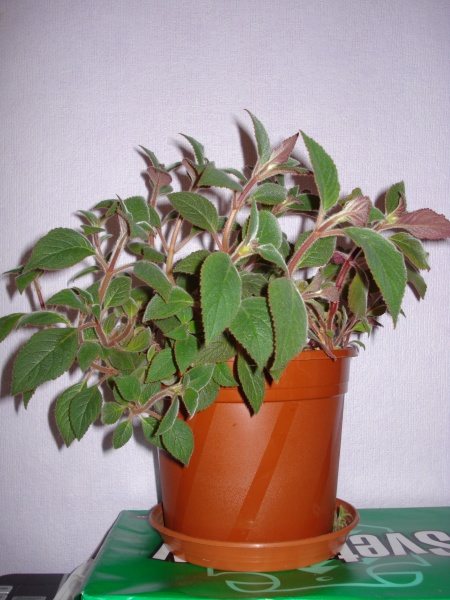

The new pot should be wide and not deep, slightly larger than the old one - be guided by the size of the flower's root system. Fill all voids in the new pot with fresh substrate gently, without tamping the soil, just shaking the pot slightly. Try not to stain the leaves - they are pubescent, it will not be easy to shake off the soil from them.
The pot can be used in both plastic and ceramic. But, a ceramic pot is preferable, since moisture retains in it longer, in the summer the root system does not suffer from the heat, and in the winter - from the cold windowsill. In addition, the ceramic pot is more stable, and the grown bush will not overturn it on its side.
Note the drainage holes in the bottom of the pot. If they are missing, you will have to drill or pierce them yourself with a hot awl (nail).
Optimal conditions in the house for growing koleriya
Coleria is unpretentious, and therefore even a novice florist can cope with its cultivation and care. Coleria attracts breeders with continuous flowering, but this effect can be achieved only if some simple rules are followed.
In order for the plant to please with active growth and generous flowering, you will need to choose the right place for the flower, ensure optimal watering, correct pruning and feeding. It is equally important, when choosing a place for installing the color scheme, to take care that it does not suffer from drafts.
Soil for koleria must meet the following criteria: have a high degree of friability, good aeration and moisture permeability, and also have low acidity.
Location and lighting
Coleria is absolutely unpretentious, but in order for it to grow normally, it will need to choose the right place in the house. She will feel good at moderate temperatures and sufficient humidity.
Coleria is photophilous, but at the same time it does not tolerate direct sunlight. In order for the plant to receive sufficient sunlight, the pots should be placed on the west or east windows.
You should not place the plant on the northern windowsills, as it will suffer from a lack of light, while on the southern ones it will receive more of it, which will also have a bad effect on its development.
Temperature range: summer-winter
Coleria is a warm and light-loving plant. In the spring-summer period, it will require temperatures from 22 to 25 ° C. But the wintering of koleria should take place at a temperature of 15 to 20 ˚C. During the budding period, it will be necessary to reduce the temperature in the room to +12 ° C, since otherwise the color of the flowers will be dull.
Lighting and pot location


Since in nature, Coleria lives in the lower tiers of tropical rainforests, it is not adapted to bright sunlight. Therefore, it should be protected from the direct sun. Lighting should be diffused. Best of all, windows of the east or west direction are suitable for the residence of the flower. In this case, the leaves of the plant become bright, shiny and thick.
Advice! If you have not yet purchased a copy of this flower, check out the article Popular species and varieties of room Coleria (Kaleria). You may like one of them.
On the northern windows, the flower will suffer from a lack of light, and on the southern windowsills - from its excess. In the first case, additional lighting will be needed using a fluorescent lamp or a special phyto lamp, and in the second, the flower will have to be protected from the sun with blinds or a light curtain.
And yet - take the pot out of the room when you ventilate the room - Koleria does not tolerate drafts.
Features of caring for color at home
Coleria, like any houseplant, requires constant care from the grower and knowledge of some of the intricacies of its reproduction. In return for care and attention, she will respond with generous flowering.
Watering mode: summer-winter
For normal growth, koleriya needs high-quality watering; for this, only settled water is used. Coleria, despite its luxurious appearance, is a very modest and undemanding plant. But in order for the beauty to feel great, it is necessary to remember that she comes from the humid forest tropics, and this will require regular and high-quality watering.
Of course, it is foolish to hope that in the conditions of an ordinary apartment you will be able to recreate the climate characteristic of the jungle, but systematic humidification of the air will make the life of the plant more comfortable.
Coleria will respond with active flowering if you provide it with generous watering, protection from drafts and an abundance of sunlight.
In autumn and winter, the frequency of watering is reduced: the next watering is carried out only after the top layer of soil in the pot dries out slightly. When cultivating koleria, only bottom watering is permissible, since moisture ingress on the leaves can cause them to rot.
Air humidity
Due to the halo of habitat, koleriya belongs to moisture-loving crops, and therefore its cultivation in a room with dry air will have a bad effect on the development of bushes. When cultivating a flower, you must be extremely careful and make sure that moisture does not get on its flowers, stems and leaves.
Due to the fact that the whole plant is covered with fine pile, it is not recommended to spray it from a spray bottle to increase the humidity; it is much safer to put a pot of color on a pallet filled with wet expanded clay, or place a container with water next to it.
It is also permissible to simply spray the air around the plant from a spray bottle.
Top dressing and fertilization
Coleria needs a systematic introduction of fertilizers, especially important is feeding for plants at the flowering stage. Fertilizers must be introduced once a week, from April to August, during the active growth of the bush. During the dormant period, the plants are not fed.
It is recommended to use fertilizers for flowering plants for feeding koleria at the flowering stage, in which nitrogen and potassium are contained in equal proportions, and the dose of phosphorus is significantly increased. Ideally, if fertilizers are prepared according to the formula NPK = 20-50-20.
Pruning and shaping the crown
Coleria – ampel plant that can be cultivated in the form of a bush.
Regardless of the shape chosen, pruning a bush is an important activity that helps to maintain a given shape and contributes to the rejuvenation of the bush. If you do not prune koleriya in a timely manner, then its shoots will stretch out and form a smaller number of peduncles.
During pruning, all dried, diseased and damaged stems are removed.
Bush pruning is done with a sterile tool. To give the plant an erect shape, all shoots that have reached a length of 20 - 30 cm are shortened by a third. Removing the tops of the shoots encourages the plant to actively form young branches.
Watering and moisture
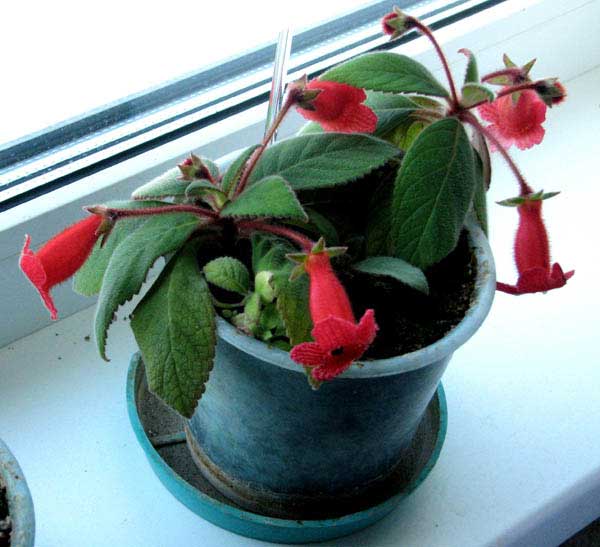

Coleria should be watered in accordance with its moisture requirement. In the spring and summer period, water should be more often and more abundantly. It is especially important to regularly water the flower during bud formation. Lack of moisture can provoke the plant to shed the ovary and refuse to bloom. Make sure that the soil does not dry out at all.
Bottom watering, in the pan, is encouraged, as this will prevent moisture from entering the pubescent leaves of the plant. Water droplets can spoil the appearance of the leaves (dark spots appear on them), and can also cause them to rot.
In winter, water the flower (if it is awake) less often, only after the top of the soil in the pot has not dried out.
Use water for irrigation only at room temperature.
The flower, which is native to the tropics, of course needs high humidity in the surrounding air. Therefore, if the humidity in your apartment is lower than the recommended one, spray the air around the pot from a fine spray bottle. It is not necessary to spray the flower so that water does not get on the pubescent leaves of the flower. If your flower does not sleep in winter, then during the heating season, its pot should be placed in a tray with wet gravel or expanded clay. But not in water, otherwise the root system can rot. To increase humidity, you can periodically dry wet towels on the battery, you can put a wide container of water next to the flower for evaporation, you can use a household humidifier if you have one.
All about transplanting koleria at home
The transplant of koleria is carried out at least once a year, which is due to its active growth rates. In order not to harm Coleria, you need to know when to transplant. It is strictly forbidden to transplant plants that are at the stage of active growth. Only bushes that are at a dormant stage are transplanted.
In order not to harm the plant during manipulation, you should act very carefully.
Planting koleria is carried out in a substrate, consisting of a part of sod land, two parts of peat, one part of leafy land and a part of refined sand in a ratio of 1x2x1x1.
Vermiculite can be used instead of river sand. In addition, charcoal must be added to each pot, which will prevent root rot damage to the plant.
The soil
The soil for Koleria should have a high degree of friability, good aeration and moisture permeability, and also have a low acidity. You cannot find ready-made soils for Coleria in the store, but soils for growing Saintpaulias (Violets) or Gloxinia are suitable. It is not difficult to prepare such soil on your own. Take 2 teaspoon of leafy soil and 1 teaspoon of sod land, peat and coarse river sand. Vermiculite can be added instead of sand. Add pieces of charcoal here to prevent root rot and other infections, as well as to retain excess moisture.
It may be interesting: Passionflower - species and varieties
In addition to the soil, you need to take care of good drainage. Prepare expanded clay, pebbles or small stones for this purpose (scald with boiling water).
Breeding methods for koleria
Coleria reproduces in several ways: dividing the rhizome, cuttings and seeds.
The plant has an increased root formation, and in order to get healthy and strong cuttings, you can simply put the trimmed parts of the plant's shoots in water, and after the roots appear, transplant them into a pot.
A feature of koleriya is the presence of rizomes. Rhizome is a creeping, root-like underground stem. It is thickened because starch stores accumulate in it; new shoots and roots of the plant are formed from the rhizome asexually. The difference between rhizomes and roots is that they have buds, nodes and scaly leaves. Coleria also has airy rhizomes.
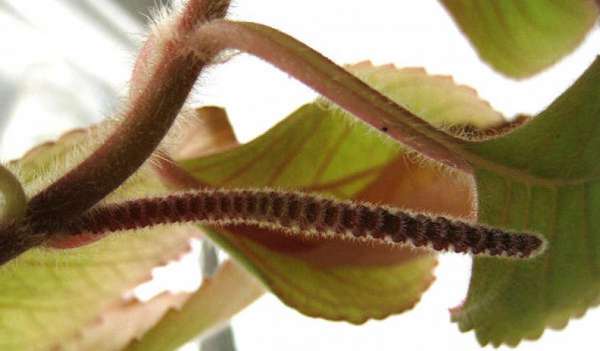

When planting koleria, it is necessary to choose a pot by size: in a too large container, soil acidification will occur, and in a small one, the root system will not be able to develop normally due to lack of space.
Division of rhizomes
By dividing the rhizomes, the easiest way is to propagate koleria, this is done during the spring transplant. To get several plants from one bush, you should carefully divide the rhizomes into several parts and plant them in new pots. It is important that each of the parts has a couple of healthy shoots and a sufficient number of roots for active growth.
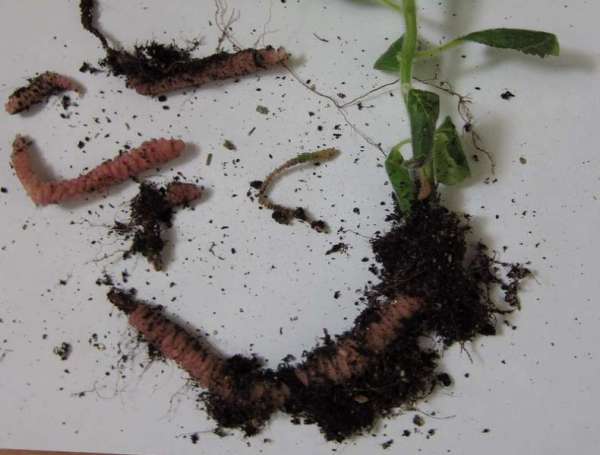

Propagation by cuttings
Cuttings are the most popular method for breeding coleria. To get a healthy plant, you just need to cut off the formed apical stalk and remove all leaves from its lower part.
To enhance root formation, you can treat the cut with any root stimulator and place the shoot in a peat-sandy substrate. Already after ten - a maximum of fourteen days, the plant will acquire the first roots, and after thirty days it will form a full-fledged root system.
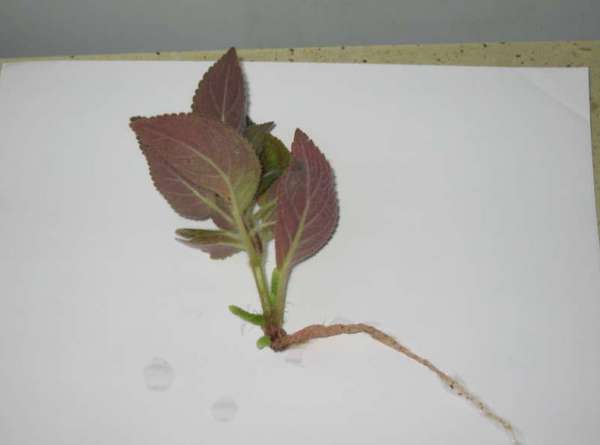

Coleria from seeds
Reproduction of coleria by seeds is the most difficult way. In addition, plants obtained from seeds very rarely retain their varietal characteristics.
Sowing of seeds is carried out in late February or early March. They are simply laid out on the surface of a substrate consisting of equal parts of sand and peat. After the grains are laid out, the soil is systematically moistened with a spray bottle, and the container itself is covered with foil or glass to maintain a stable microclimate.
Seeds germinate in 2 to 3 weeks. After the seedlings get stronger, they are transplanted into separate containers and further looked after, as for adult specimens.
Growing Koleria from seeds
Obtaining Coleria from seeds is the most difficult and unpredictable method of reproduction, since such plants, when growing, rarely retain their varietal characteristics. If you have chosen this particular method, we advise you to purchase seeds in specialized stores.
Choose a time to sow Coleria seeds between late January and early March. Prepare a greenhouse for sowing, for example, a container with a lid or a deep box with glass. Spread the seeds on the surface of a moist substrate, consisting of the same amount of peat and sand, at some distance from each other. Close the container lid. Place the seedlings in a warm (about 23 - 25 g), bright place for germination. If necessary, ventilate the greenhouse and moisten the substrate.
The seeds will germinate in 2 to 3 weeks. Wait until the seedlings get stronger, when they have two to four true leaves, and then transplant each sprout into a separate pot with a diameter of 7 cm.Before the bush is formed, pinch the tops of the seedlings to stimulate them to form side shoots.
Pests, possible problems and diseases of koleria
Coleria is quite resistant to phyto-infections and pests. More often than not, all her illnesses are caused by a violation of care.


The most common problems arising from the cultivation of koleria:
- Lack of flowering - indicates that the plant is suffering from a lack of sunlight or nutrients. This problem will be solved by rearranging the plant to a more illuminated place and the introduction of top dressing.
- The appearance of dark spots on the leaves is explained by watering with cold water. Do not forget that watering the bushes is permissible only with well-separated water at room temperature.
- Yellowing and excessive stretching of shoots - the plant suffers from a lack of ultraviolet radiation. To improve the appearance of the plant, it will help to rearrange it to a lighter place.
- Leaf curling is a symptom that the bush is suffering from a lack of moisture. To increase the humidity, place containers of water next to the pot.
- The lethargy of the leaves is a sign that the roots of the bush are affected by root rot. Transplanting the plant into new soil and completely removing damaged roots will help solve the problem.
- Thermal burns occur when the bush is exposed to direct sunlight. To end the suffering of a plant, simply move it to another place, and remove the damaged leaves.
- The appearance of a gray bloom indicates an infection of the bush with oidium. Treating the leaves with soapy water will help to cope with the disease.
Coleria is absolutely not capricious and unpretentious, and therefore, in order to get a beautiful and healthy bush, you will need to follow only a few simple rules for its cultivation.


Coleria belongs to perennial herbaceous plants from the Gesneriaceae family. Despite the ease of growing and a long flowering period, this indoor flower is not a favorite of flower growers. The flower owes its name to the teacher Michael Kohler. Other names for koleria are also known - tydea and izoloma. In nature, it is found in Colombia, tropical America, on the island of Trinidad.
Coleria is considered an ampelous plant. Its characteristic feature is elongated and velvety green leaves with jagged edges. Coleria flowers resemble asymmetrical elongated bells. Most often, koleriya is bred with red flowers. But there are plants that have pink, maroon and orange flowers. The flowering period lasts from June to October, but with proper care, the plant can bloom almost all year round.
Coleria is characterized by a dormant period. As a rule, it falls on October-March, when the plant stops blooming. In some cases, the ground part dies off. If optimal conditions are created for the plant, then the dormant period will not come.
Varieties
The genus of the plant has about 65 species, but only a small part is grown as indoor. They differ:
- colors of buds and foliage;
- dimensions;
- place of growth in natural conditions.
Common varieties and types:


- "Sunshine" is a compact, abundant and long-flowering cultivar. The leaves are dark green with a velvet sheen. The flowers are pink with two darker petals. The throat of the flower is light with a lemon shade and dark red dots, stripes and strokes located throughout the flower.
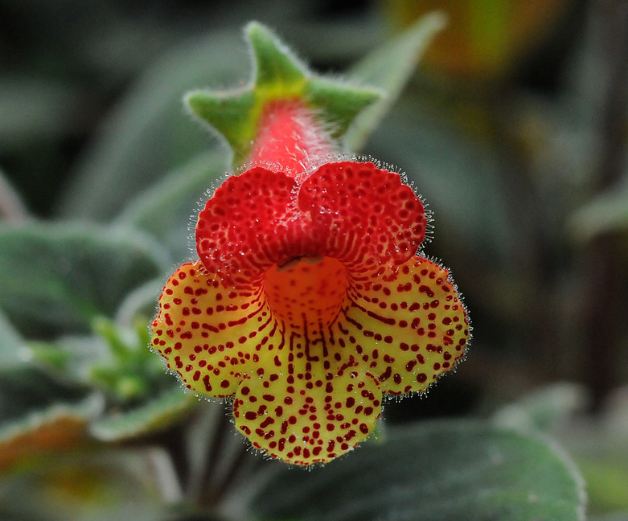

- "Bogotskaya" (Kohleria Bogotensis) is a perennial that grows on stony soils. The plant is quite tall - up to 60 cm. The stems are single, straight. Leaves are oval, slightly widened, dark green with light pile. The inflorescence consists of two bright red flowers, inside the petals are brown-red with dots, stripes or spots. Flowering is not long, lasts from mid-summer to early autumn.
- Fluffy (Kohleria eriantha) is a compact plant up to 45 cm high. The buds are covered with dense edging. Flowers of orange or scarlet shades, there are varieties interspersed with cream or white. It blooms all year round without a pronounced dormant period. Leaves are broadly oval, saturated dark green with red bristles.
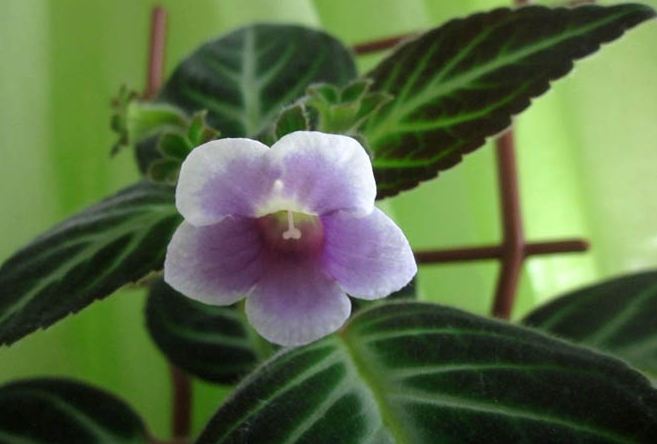

- "Lindena" (Kohleria lindeniana) is a low plant, up to 30 cm tall, whose homeland is Ecuador. Stems and leaves are covered with a light fluff. The leaves are velvety, oval, dark green in color with light veins. Several buds appear on the peduncle at once. Future flowers will be painted white on the outside and purple on the inside.


- "Red" (Kohleria Red) is the most widespread and popular type of koleria. The petals are bright red with specks.
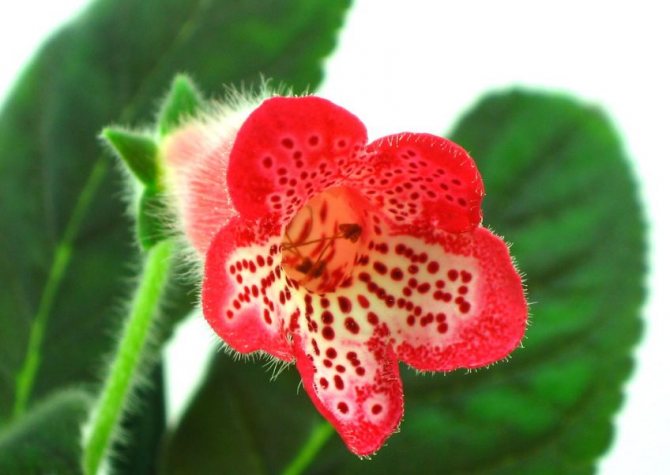

- "Manchu" is a compact, low plant with light green velvety foliage. Flowering is year-round. The flowers are fluffy with interesting and complex colors of the petals: the tube and neck are bright orange with dark red spots, the two upper petals on the lapel are red with crimson dots, the three lower ones are creamy white with burgundy spots and a red border. Differs in a particular predisposition to fungal diseases.


- "Varshevich" (Calathea warscewiczii) is a large perennial. It occurs naturally in Panama, central USA, El Salvador. It grows to a height of about 40 cm. The leaves form small rosettes. Petioles and leaves grow up to 20-55 cm. The leaves are fleecy, ovoid. A fine-toothed pattern is located on its upper part and along the central vein. On the reverse side, the petioles and leaves are brown. Peduncles are small, crimson. Abundant flowering. The flowers are large, white or beige with burgundy dots. At night, the foliage folds into buds and rises to the top, showing the brown tint of the reverse side of the leaf. Blooms from May to July.


- "Spikelet" (Kohleria spicata) - originally from Mexico. Miniature plant with oblong-oval leaves. The flowers are red on long stems, orange in the fauces.
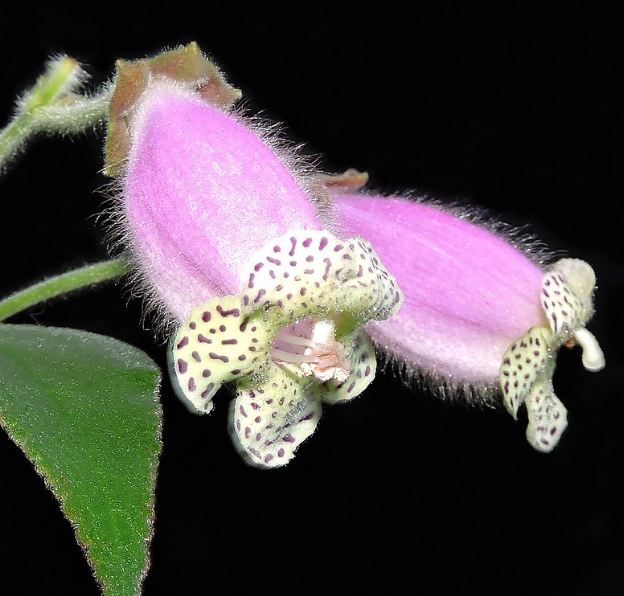

- “Foxglove” (Kohleria digitaliflora) is one of the smallest species with straight shoots. Leaves are ovate-lanceolate, green, on short petioles, up to 20 cm in length and up to 10-12 cm in width. The bottom is covered with a thicker pile than the bottom. The inflorescence is axillary, contains 5 or more flowers. The corolla tube is white with a pink tint in the upper part, up to 3 cm long. The pharynx is green, along the limb with purple dots. Blooms profusely in autumn - August-September.
Caring for paintwork at home


Temperature
The plant is perfect for a moderate indoor temperature. During the growing season, the optimum temperature will be 20-25 degrees. In winter, with the onset of a dormant period, the temperature is lowered to 15-17 degrees. The room where the flower is located should be ventilated very carefully - the colleria cannot stand drafts.
Coleria belongs to light-loving plants, therefore it prefers well-lit places. Diffused light will suit her. The flower should be protected from direct sunlight. The most comfortable koleriy will be on the east or west window. If the dormant period has not come and the plant has not thrown off the foliage, then you need to take care of good lighting.


Coleria needs moderate watering during the period of intensive growth and abundant flowering. Water for irrigation should be soft, well-separated, warm. Waterlogging of the soil can cause the development of fungal diseases. Preference is given to bottom watering, as water should not fall on the leaves. Due to the drying out of the earthen coma, the plant may die. In winter, watering is minimized. If in winter the aboveground part of the koleria has died out, the soil is periodically moistened to avoid drying out of the rhizome.
Air humidity
Coleria prefers a humid microclimate, but perfectly adapts to dry air in an apartment. You cannot spray the plant. Water droplets can damage ornamental velvety leaves. To create high humidity, the air is sprayed around the plant. It is advisable to put a container with a flower in a pallet with wet expanded clay or moss.
Reproduction
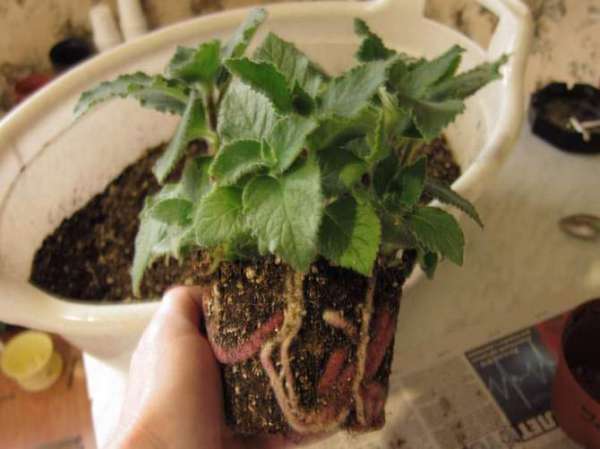

There are several ways to breed coleria.New plants can be obtained by seed, dividing the rhizome and rooting apical cuttings. The simplest ways to reproduce koleria are rooting cuttings and dividing the rhizome. You can propagate an indoor flower at any time of the year. But the most favorable period is spring.
Apical cuttings root well in water. After rooting, they are planted in shallow pots, placed in the ground to a depth of 2 cm. In order to avoid drying out of the soil, it must be moistened.
Coleria is a fast-growing indoor flower that needs an annual transplant. Wide and shallow pots are suitable for the plant. The soil substrate must always be new. It should include sheet soil and sand in a 2: 1 ratio. There should be good drainage at the bottom of the tank and a hole for draining water.
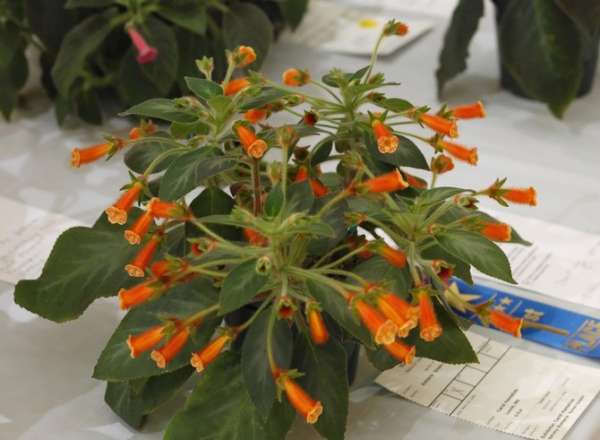

Coleria needs constant fertilizing with mineral fertilizers for flowering plants. It is fertilized once a week during intensive growth, from April to August. During the dormant period, feeding is not performed.
Diseases and pests
Coleria pests are extremely rarely affected. If the leaves and shoots dry and deform, then they are threatened by spider mites and aphids, which suck the juice from flowers and leaves. Over-watering the plant can get sick with root rot or powdery mildew. The appearance of a gray coating on the leaves indicates a fungal disease.
Despite the fact that koleria is unpretentious, it is a very delicate plant. To prevent stains from appearing on the leaves, they should not be touched or sprayed. Otherwise, koleriya will shed the foliage and lose its attractiveness. Yellow spots on the leaves appear from direct sunlight.
Pruning for the winter and care during the rest period
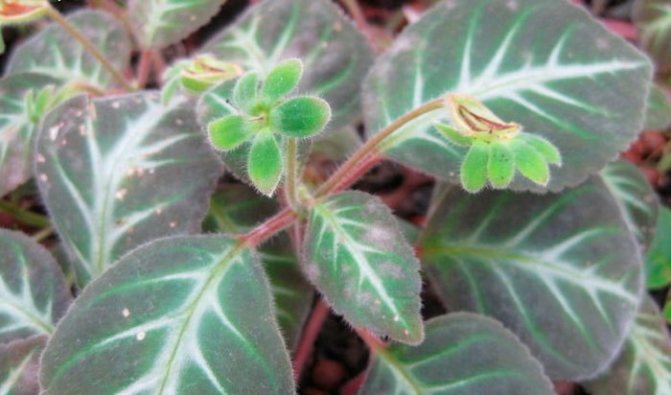

In autumn, when the flowering of Coleria ends, its greenery begins to fade. The leaves lose their turgor and begin to dry out. At this time, you should cut off all wilted parts of the plant, up to the rhizome, leaving only a small part of the stem on the bush. Move the pot with the rhizome to a cooler room (15 grams) with moderate lighting for the whole winter. Do not feed. Do not spray ambient air. Reduce watering to two or less times a week, although do not allow the root system to completely dry out - the flower will die. In this state, Koleria should hold out until January.
Some Koleria varieties do not have a dormant period and require some care in winter. After flowering, they keep all the leaves on the shoots green. Then leave them, the way they live all winter on the windowsill. For such flowers, you do not need to lower the temperature and lighting, just water more moderately and do not feed.
It may be interesting: Description of the species and varieties of Streptocarpus with a photo
Possible problems
During the cultivation of calories at home, the following characteristic problems may appear:
- if watering rules are not followed or if water gets on the leaves, small brown spots of irregular shape may appear;
- if the flower is constantly exposed to direct sunlight, yellowing of the leaf plate appears. Sometimes this problem occurs due to the abuse of feeding;
- due to the lack of mineral and organic compounds in the soil, growth retardation is possible, as well as the fall of buds and flowers;
- in case of insufficient illumination, the shoots are bare, the leaves and ovaries of buds are practically not formed.
If you notice and eliminate the cause of the problem in time, then the plant quickly recovers and continues to actively grow and form buds. Prolonged exposure to moisture and sunlight can kill the flower.
Formation of the crown of koleria
In order for the bush to be lush and densely leafy, you should pinch the tops of the shoots in time, stimulating the growth of lateral shoots. They start from the central shoot: cut off the growing point above 6-8 leaves with scissors.
In this case, axillary shoots will begin to actively develop, they are treated in the same way: the tops are cut off above 6-8 leaves, or above 3-4. This pinching will allow you to keep a compact bush with lush leaves and twigs.
If you do not pinch the coleria, it will grow into one trunk, the view will remain completely unattractive: the plant will stretch out, and in many cases the coleria can even lie down, hanging ugly from the pot.
Description of koleria
Coleria grows in the shade of tropical rainforest trees, shrubs or semi-shrubs, 60-80 cm high. The leaves are located on the stems one opposite the other. They are oval in shape, elongated, toothed edges, pubescent, up to 18 cm long, 8 cm wide. The colors of the leaves are different: dark green, emerald with red veins. There are olive and light veins on them. Hybrid varieties have a silver, bronze color.
Unusual flowers (1-3 in the inflorescence) are asymmetric, reminiscent of a bell, a tube up to 5 cm, a corolla narrowed near the throat and swollen at the other end. The throat is open, decorated with specks, dots or strokes, it has five lobes. Flowers can be of one color, and the throat - another speckled. It blooms in July and blooms until the end of November.
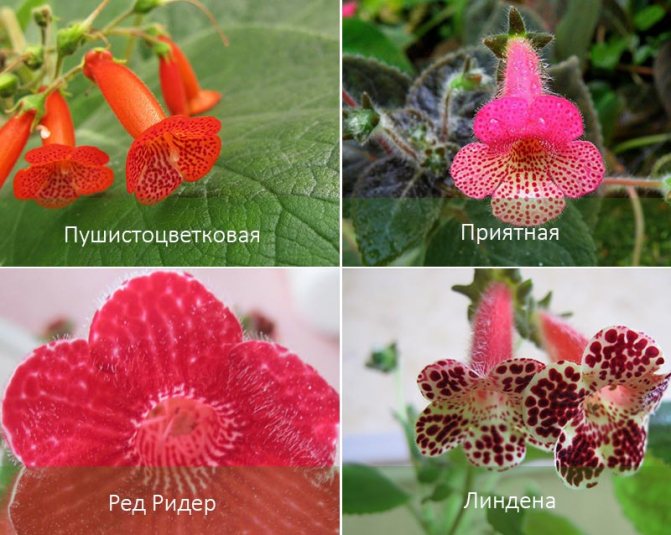

The root system consists of rhizomes or tubers covered with scales. Outwardly they look like a pine cone.
Flower diseases and treatment methods
Coleria is prone to the appearance of such problems:
- Brown spots on the leaves.
They can appear due to improper watering or stagnation of moisture on the leaves. To get rid of this problem, you need to water the flower with lukewarm water, without touching the leaves. - Leaves turn pale or yellow.
To get rid of this trouble, you need to remove the flower from direct sunlight and reduce the amount of feeding. - Gray bloom on the leaves.
This is caused by the defeat of the fungus, which can be eliminated by reducing the humidity of the air and soil. - Twisted leaves.
This fact speaks of dry air. To heal the plant, it is required to spray the air around it with warm water. - Withered leaves
: lighting should be added.
Coleria is considered a plant that is resistant to various diseases or pests. Usually, both problems are directly related to improper care. For example, with excessive watering, koleria can get sick with powdery mildew or root rot.
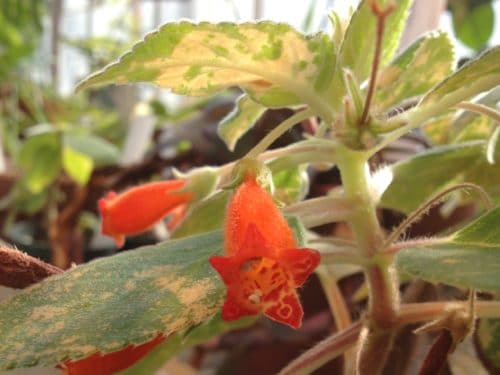

Pale leaves with yellow spots - the result of direct sunlight
Reproduction
The optimal time for plant propagation is spring. Although, if necessary, this can be done in other seasons.
There are several ways to propagate this plant. Leaf propagation is rarely used - it takes too long to wait for the roots to appear (up to 5 months).
By dividing the rhizome
- When transplanting, divide the rhizome into several parts (preferably no more than 3) with a sharp knife.


When transplanting, the rhizome is divided into 2-3 parts
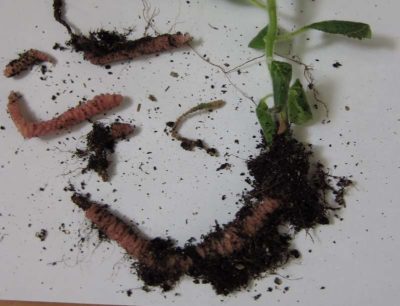

Pieces of rhizome are planted in different pots
Seeds
- To obtain kaleria seeds, artificial pollination must be used. They can also be purchased.
- Seeds are planted in the second half of winter.
- A mixture of peat and sand is required (or 1 part sand and 2 parts sheet soil).
- The seeds are simply placed on the soil without deepening.
- Cover the pot with plastic.
- Ventilate daily to prevent mold. Water it periodically.
- When 2 leaves appear at the seedlings, the seedlings are dived and planted in separate containers.
- After the seedlings have grown, the upper bud is removed to stimulate the development of lateral shoots.
By cuttings
- Prepare cuttings - cut off the top of the stems.
- Powder the slices with Kornevin.
- Place in water (heating from below will speed up the emergence of roots).
- When the roots appear, plant in a small pot (required soil: sand or a mixture of peat and sand).
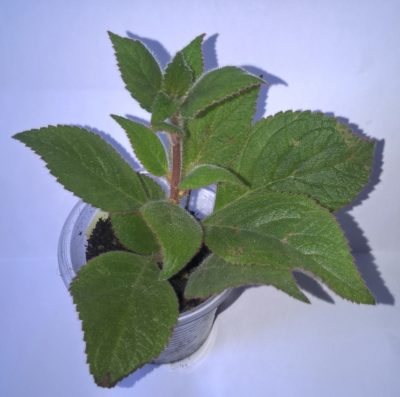

Kaleria grown from cuttings
Microclimate
To achieve a bright and long-lasting flowering of a plant, it is imperative to create optimal conditions for koleria.But, many novice flower growers neglect this requirement, as a result of which the indoor pet is often sick, and in neglected cases dies. Therefore, for koleriya it is imperative to create the necessary lighting, temperature and water conditions.
Home koleriya belong to the thermophilic and light-loving representatives of the flora. The flower grows and develops best in places with intense but diffused light. Prolonged exposure to direct sunlight is undesirable for the plant, as this can cause thermal burns to delicate foliage or flowers. The best place for koleriya is considered to be window sills on the east or west side. During the dormant period, flowerpots can be transferred to unlit parts of the house, but to activate the spring growing season, they must be placed in their former place.
The plant is able to sustainably tolerate temperature fluctuations throughout the day. Despite the southern roots, it is capable of developing at a temperature of 10 ° C, but prolonged decreases in the indicator to 5 ° C and below are destructive for it. In this case, the optimal temperature for keeping a flower is considered to be a range within 20 ... 25 ° С.
Coleria respond well to humid air, but grow well even at low humidity. At the same time, it is forbidden to spray the flower, this is due to the fact that its villi are able to retain moisture, and this is the best condition for putrefactive lesions. Therefore, they irrigate the air away from the plant or install small containers of water next to the pot.
Important! Koleria does not tolerate drafts well, therefore, it is necessary to ventilate the rooms where it lives with caution. Otherwise, the plant may die.
The best varieties of coleria with photos and names
Coleria variety Manchu Manchu
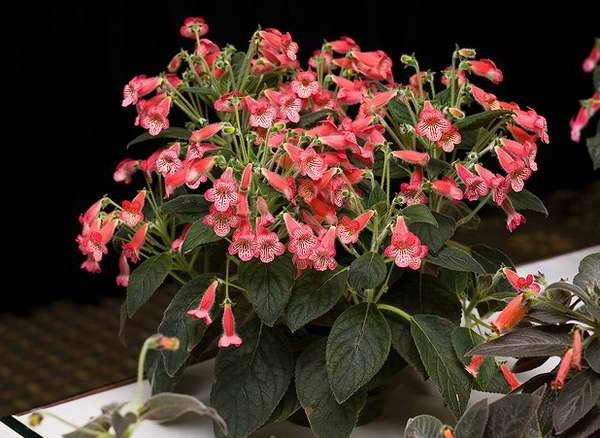

Coleria Manchu photo
The poured leaves are light green in color. Orange-colored flowers are covered with burgundy specks along the hem.
Coleria variety Rongo Rongo
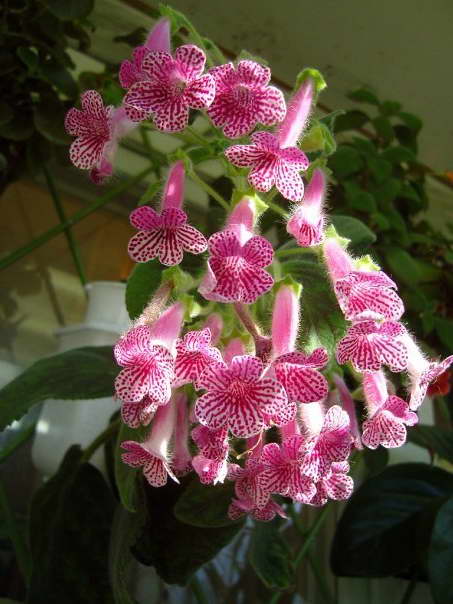

Coleria Rongo Rongo photo
Leaves of a light olive color are covered with veins of a lighter shade. The flowers have a pale purple color, the inner side is covered with a burgundy speck.
Coleria variety Sunshine Sunshine
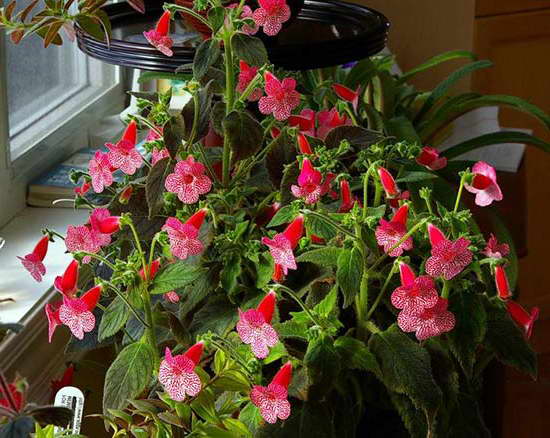

Coleria variety Sunshine Sunshine photo
Compact variety with dark green leaves. The flowers are pink, a pair of limb petals have a darker shade, the entire limb is decorated with maroon specks.
Coleria grade Mother's Lipstick
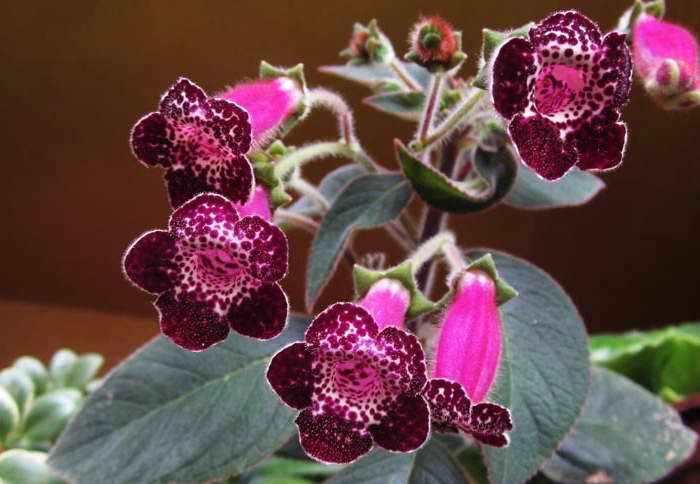

Kohleria Mother's Lipstick photo
The interesting name of the variety "mother's lipstick" is quite justified: the flowers look very impressive. The play of deep pink and dark burgundy shades, interspersed with white spots really create the illusion of gloss on the lips.
Coleria hybrid sciadotydaea hybrid
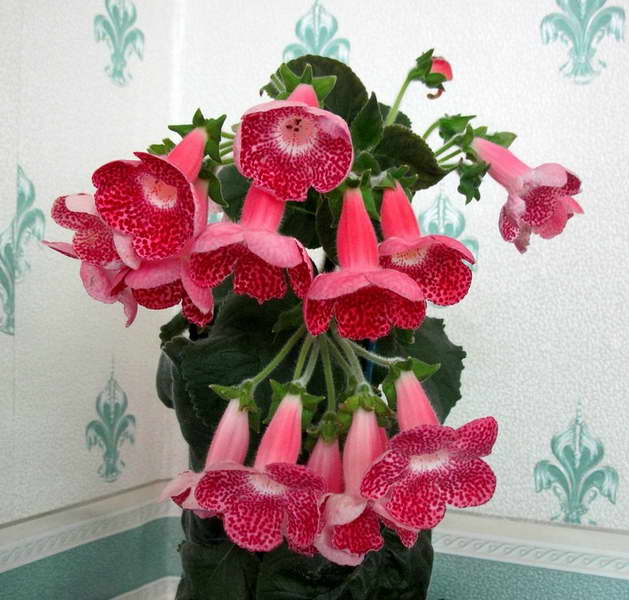

Coleria sciadotydaea hybrid photo
The sciadotydaea hybrid has very large velvety flowers with pink and scarlet colors. An interesting bit pattern on the obverse of the petals creates the illusion of expensive fabric against the background of a dark green canvas of equally luxurious leaves.
Blitz summary
- Coleria is a beautiful and delicate flower that requires attention and care.
- The flower doesn't like a lot of light.
- The plant should grow in a humid environment.
- The flower must be fertilized in the spring.
- For the winter, the plant should be removed in a dark place.
- It is necessary to propagate the flower in the spring.
- It is necessary to monitor the moisture content of the soil in order to avoid fungi and rot.
- The crown of the coleria is not cut off, but plucked.
- The air temperature for the normal development of the plant should range from 19 to 27 degrees.
Brief description of cultivation


- Bloom... In July – November.
- Illumination... Needs bright sunlight, which should be diffused.
- Temperature regime... In summer and spring, from 22 to 26 degrees, and in winter, from 16 to 18 degrees.
- Watering... In the spring and summer, it is necessary to water abundantly and often; in the autumn, a gradual reduction of watering is carried out. In winter, watering should be scanty and rare, while the clod of earth should not be allowed to completely dry out.
- Air humidity... Common for rooms in living quarters.On hot days, the container with the bush must be placed on a pallet filled with moistened expanded clay.
- Fertilizer... It is necessary to feed the flower in April-October 1 time in 7 days; for this, fertilizer is used for flowering plants.
- Dormant period... November – March.
- Transfer... If necessary at the beginning of intensive growth.
- Suitable soil mixture... It should include leaf and turf soil, sand and humus (4: 2: 1: 1).
- Reproduction... By seed method and cuttings.
- Harmful insects... Scabbards, spider mites, whiteflies, thrips and mealybugs.
- Disease... If the bush is improperly looked after or placed in unsuitable conditions, then it may have problems with foliage or with flowering.
Useful properties of koleria
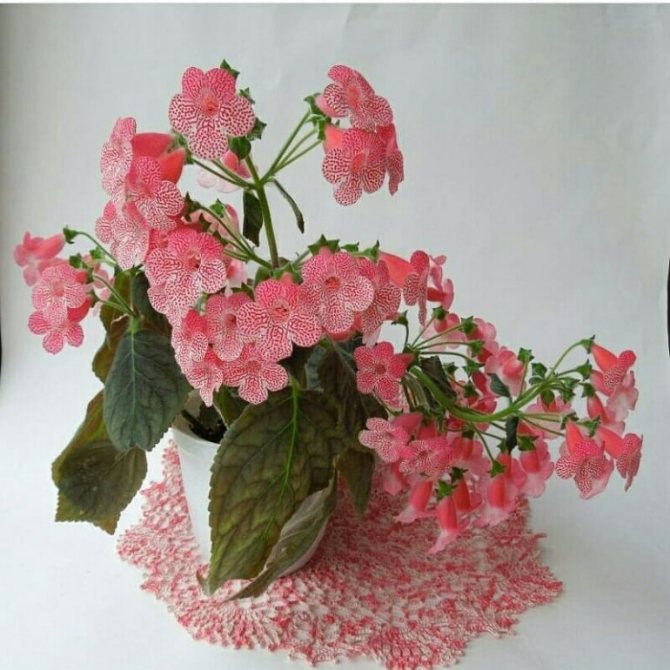

Coleria is a safe, non-poisonous and absolutely non-allergic flower, which is able to clean the air from impurities, traces of smoke, dust and toxic compounds. The plant saturates the surrounding space with oxygen, ionizes and refreshes the air.
Therefore, it can be considered an ideal option for placement in the nursery, in the bedroom, in the kitchen.
Comments (2)
Ulya
16.12.2015 at 00:28 |
A beautiful plant, I wanted such a flower for myself, I had never seen such a flower before. This Karelia is unpretentious in water and in care. Need to look in flower shops. Is this plant affordable for the average person?Reply
Julia Expert Plodogorod
25.10.2018 at 20:54 |
Hello Ulya! If in the matter of acquiring this flower you are confused only by the possible high price, then you should not worry. It can be purchased from a flower shop or online shopping sites for a small fee.
In addition, you only need to purchase the first pet. Then you can multiply your kaleria. This can be done in several ways. Both by division and by seeds and cuttings.
Although kaleria rarely gets sick, carefully examine it before buying, otherwise the plant may die and infect other flowers in the house.
Most often it is affected by aphids and spider mites. The latter is not so easy to notice, but very difficult to deduce. Look for small yellow dots and a thin cobweb on the leaves and flowers. You can use a magnifying glass. Touch the leaves gently, they should not be sticky. If there is such a feeling, it means that the plant is still affected by aphids.
Since the store can simply wash the flower so that such problems are not visible for prevention, it is worth buying special tablets that are inserted into the soil of the pot. They help control most pests and are nutritious.
Reply
Kaleria types
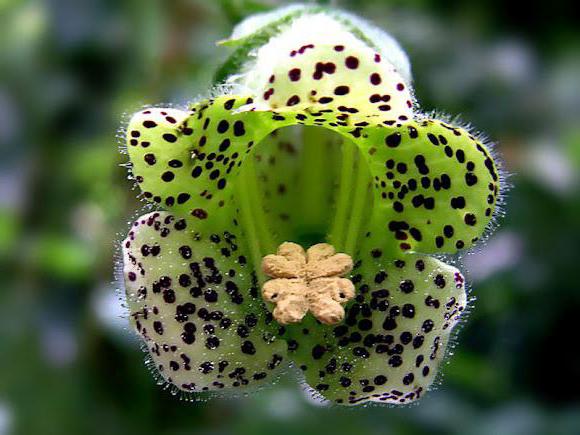

If you want to grow a spectacular, unpretentious and rare plant, then let it be kaleria. Caring for her is elementary simple, and the flowering is great. Before buying, be sure to clarify what kind of species you are getting, since some of the features of its cultivation may depend on this. Several hybrids are common in room culture, including the following:
- Bogotka kaleria is a plant that in nature reaches 60 cm in height. Has characteristic pubescent shoots and dark green leaves with reddish villi. Flowers are single or paired, drooping. The corolla is red with spots and stripes, and the inside is painted in a yellow tint.
- Kaleria is pleasant - green shoots grow up to 60 cm, often have white, long hairs. Leaves are deep green in color with noticeable silvery or reddish veins. The arrangement of the flowers is axillary, the shade is pink with purple spots, and inside is yellow.
- Kaleria foxglove - the name is associated with the similarity in the appearance of flowers. White corolla (up to 3 cm), turning into a light pink color to the upper part, the pharynx is green with purple splashes.
Features of the view
The tropical origin is a direct consequence of the basic requirement that the koleriya plant makes to the grower: care and reproduction are possible only in a warm room.Therefore, the microclimate of an ordinary room is quite suitable for her. The color scheme does not put forward any harsh conditions for humidity, lighting or temperature limits. Nevertheless, we list the optimal conditions, the fulfillment of which will allow the plant to fully reveal its potential and amaze with the beauty and generosity of flowering.
Flowering plant
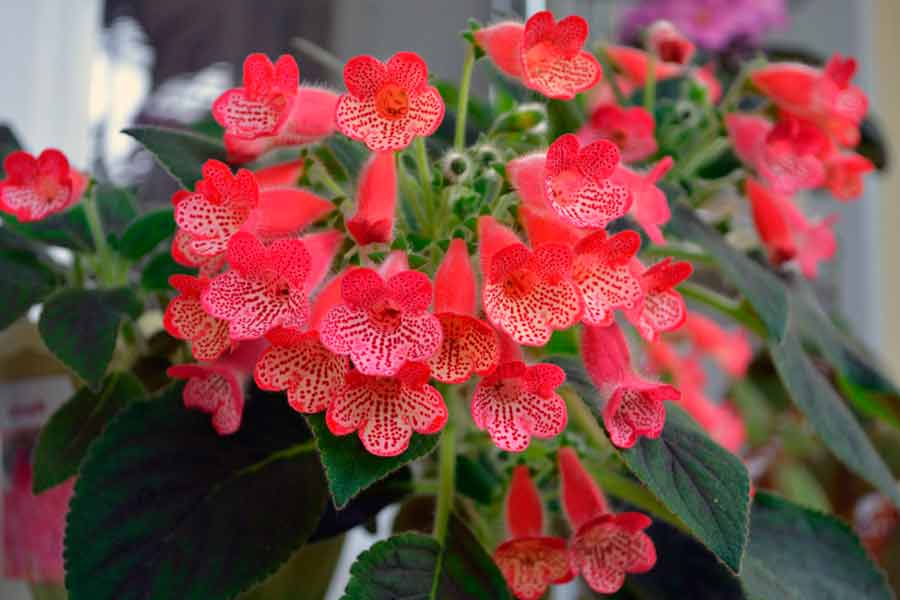

At home, kaleria has a periodicity of vegetative periods. Active growth occurs from the beginning of spring, after reaching a long daylight hours, with proper care, flowering continues almost all summer, until the beginning of autumn. It is recommended to pluck withered buds as they take up some of the nutrients. Then the plant goes into a dormant stage, which can be seen by its characteristic wilting. At this point, you need to shorten all the care procedures.
Main varieties
Coleria is striking in its variety. Today, a huge number of all kinds of varieties are known, differing not only in the bright color of the flowers, but also in the shape of the bush. In addition, specimens are often found that are distinguished by velvet leaves or pubescence of all kinds of flowers.
The most popular flower varieties:
- Ampallang - the flowers of the variety have a rare shade of fuchsia, which is decorated with small purple specks. Dark veins are clearly visible on the leaves of the plant.


- Fluffy - a distinctive feature of the variety is the increased velvety of flowers and green mass. Fluffy coleria has large flowers of red or dark orange color, complemented by yellow dots in the lower part.
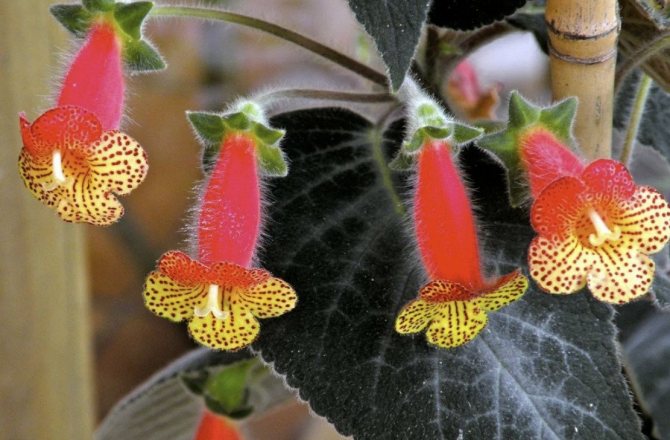

- Queen Victoria - The flowers of this variety look like small tubes. Their inner part is white, with dark pink stripes and a white border, and the outer part is a delicate pink shade.


- Lindena - representatives of the variety are distinguished by velvety dark green leaves covered with silvery down, as well as purple flowers outside and white inside.
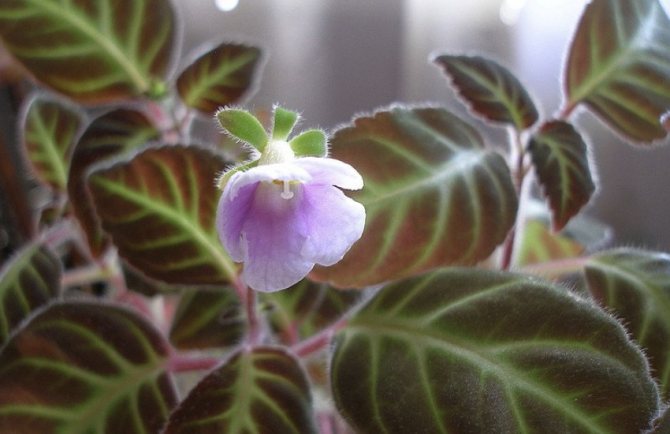

- Bibby is one of the brightest varieties. It has large white flowers, with a yellow throat and cherry dots. They are complemented by rich green leaves, covered with pubescence.
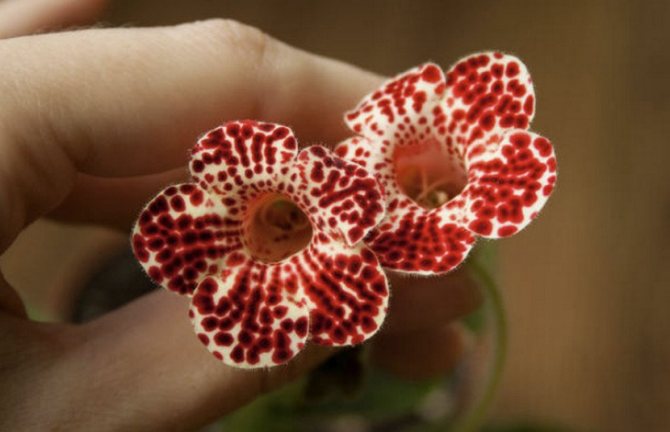

- Flashdens - this plant has a large coral flower with pink stripes, it is complemented by tubes and pale yellow petals.


- Bogotka - the plant consists of small scarlet inflorescences, covered with numerous hairs. The inner part of the inflorescence has a bright orange tint, with small red dots.
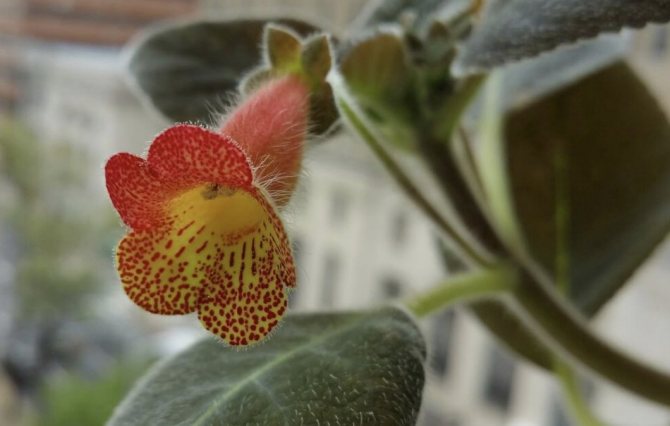

- Red - this color scheme is small in size and small flowers, saturated red or dark red.
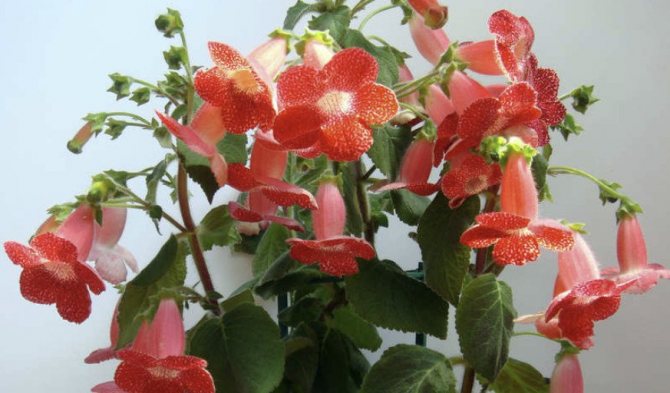

- Varshevich - it is distinguished by large variegated pink flowers, they are complemented by light green petals and a tube, covered with numerous cherry blotches.
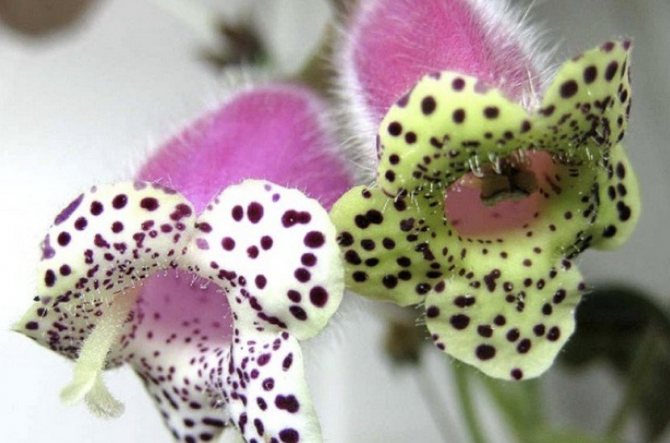

- Majestic (magnifica) - amazes the variety with huge flowers resembling bells. They have a red-burgundy color, complemented by scarlet blotches. Also, the variety is distinguished by green leaves covered with an ornament resembling a quilted bedspread. On the underside, the leaves are covered with white hairs.
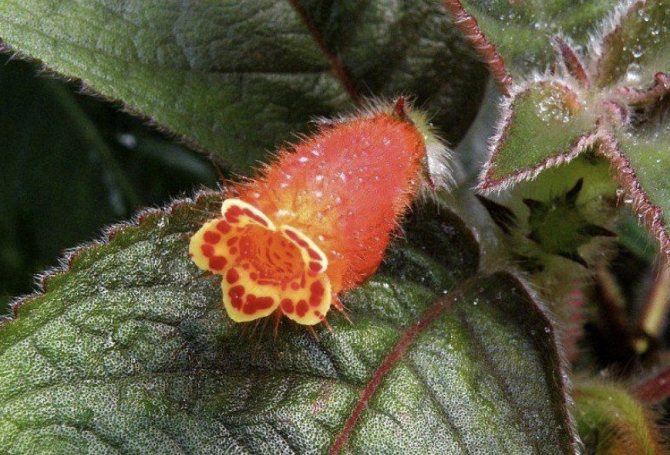

- Tubular - the variety is characterized by elongated tubular flowers, orange tones. They are gracefully complemented by a pharynx with a characteristic line pattern, while the leaves have a bright and rich green color.
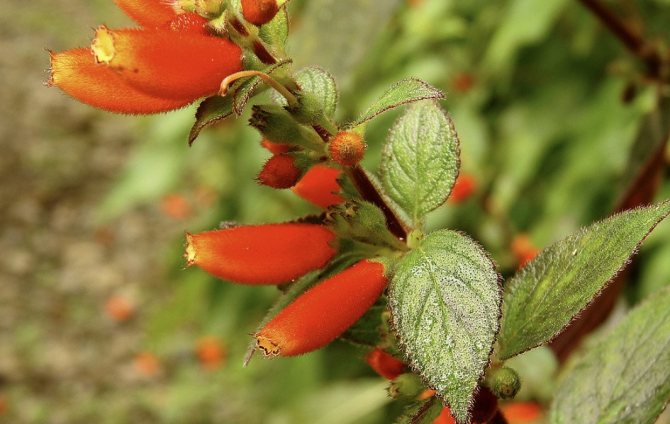

Landing
Kaleria in the wild grows on rocky poor soils, so it is not very demanding on the soil. Transplant it if the rhizome has already completely filled the pot. The best time for transplanting (more precisely, for transshipment) is spring. For a plant, you should take a shallow and wide container.


Calories are transplanted by the transshipment method
A mixture of earth: 2 parts of leaf land, 1 part of peat, 1 part of sand, 0.5 part of humus, a little charcoal (to absorb excess moisture). You can also purchase ready-made soil for Saintpaulia or Gloxinia. At the bottom of the pot, it is imperative to place a 2-centimeter layer of drainage - pebbles, expanded clay, brick.
There is no need to clean the root from the ground, you can immediately place it in a new container by transferring it and sprinkle it with fresh substrate.
Video: planting kaleria
Testimonials
After flowering somewhere in October, I cut the stem completely to the ground. Can be put away like gloxinia for storage. Or you can leave it on the window. When the scaly rhizomes germinate, I give the shoots to grow, and then cut and root. Such plants turn out to be more beautiful and compact. I throw away the rest that remains in the pot. Rooted plants grow new scaly rhizomes during spring and summer. Thus, the plants are renewed all the time. For insurance, you can root cuttings cut in the fall.
Perl
Florist reviews about growing
Kaleria - when you pronounce this name, it seems that it rolls on your tongue. It has been growing for me for many years and I cannot get enough of it, you can admire it all day long. Kaleria is not too whimsical, but he loves a sunny windowsill and absolutely cannot stand drafts. But it grows and blooms, almost continuously. And what beautiful flowers she has! The shape of the flower resembles a bell with an unusual spotted red coloring. And this beautiful flower multiplies very simply - after flowering, you need to cut off the top and put it in water. And after the appearance of the first roots - feel free to plant in a pot with earth. I always take ordinary garden soil, all my indoor plants grow and bloom just wonderfully in it. Watering the kaleria must be very careful, trying to prevent water from getting on the leaves, from this they rot. If you follow such simple rules, then this beauty will bring you many pleasant minutes and will cheer you up.
pomidorastr
Coleria must be formed from a small cutting. As soon as a process of 5 centimeters appears, we begin to pinch. It will branch out and form into a bush. This will delay flowering a little.
Nika
She should rest in a cool, dark place in winter, I put it in a black bag and put it under the balcony door, in January-February I take it out and very carefully so as not to pour it over or ruin it, I start watering.
Irena_Obninsk
The lighting is sunny, watering is abundant, does not tolerate spraying, pruning is not required, propagation by apical cuttings or dividing the root, feeding from spring to autumn after 2–4 weeks. Good luck! The flower is gorgeous, but harmful.
dormidont
Kaleria is perfect for growing at home. She does not need frequent watering, any special conditions of detention, lighting, humidity. And beautiful flowers delight the owners for quite a long time.

